Volume 28
Global Warming-Induced
Catastrophic Equatorial Icing
- An Airline Safety Emergency -
Editors' Note
Since a presentation in 2005 at Scripps, Executive Editor Prof. Carl Gibson, of UCSD/Scripps, has been sounding the alarm about a new airline safety issue caused by global warming. His papers and comments
on this have appeared in various volumes of the Journal of Cosmology and other publications. The Editors believe this body of work in the Journal should be available in a single volume and this is
that volume.
The Editors also hope this compilation will help bring this extremely serious issue forward in the scientific community. The Journal has been trying to get satellite thermal imaging of the ocean areas
between 10N and 10S latitudes to look for CEI events, but to no avail. We are hoping others in the scientific community will now come forward to request the scans that could prove or disprove the
existence of CEI events.
We are proud to announce that Prof. Gibson was nominated for the 2019 John Maddox Prize. for his hard,
dedicated, work on CEI. View his nomination by Roger N. Keeler HERE and view his nomination by Nalin Chandra
Wickramasinghe HERE
The Editors are also soliciting papers and commentaries supporting Prof. Gibson's work to be included in this volume.
The papers and comments that follow are listed chronologically, oldest first. The item numbers are for their positons in the original volume's Table of Contents.
CONTENTS
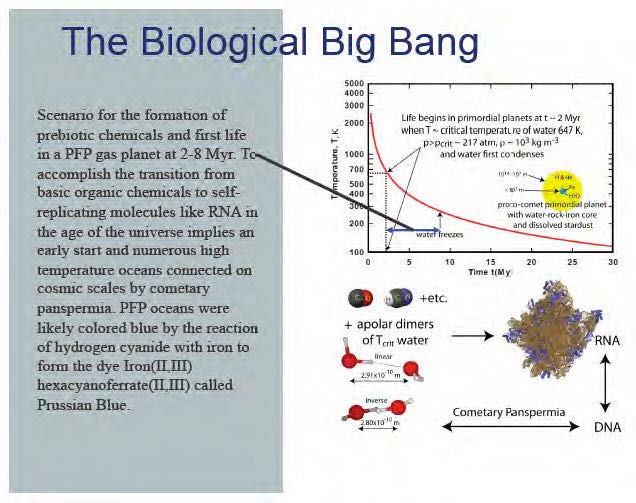
Vol 28, #27. Catastrophic Equatorial Icing kills Lion Air 610 plane and all 189 aboard: NOT terrorists, Boeing Avionics or Pilot error. Carl Gibson, Professor at University of California at
San Diego and Hanlin Liu, Student of Economics and Business Administration at the University of North Carolina at Chapel
Hill. An examination of the financial impact of CEI crashes. pp 15325 - 15327.
Vol 21, #58. Fossil turbulence and fossil turbulence waves permit remote sensing of submerged submarines, Carl H. Gibson, pp 9882-9894 JARS version. Reviewer comments.
Vol 23, #18. The case for Equatorial Icing as the cause of Air France 447 and Malaysia Airlines MH 370 Catastrophies. Carl H. Gibson.
Vol 24, #17. Catastrophic Equatorial Icing Caused the Air France 447 and Malaysian 370 Crashes. Risks of More Such Disasters are Increased by Global Warming, Carl H. Gibson, AGU Fall Meeting, San Francisco, A43A-3241, Moscone South Poster Hall, December 18, 01:40 to 6:00 PM. Poster, pp 12291-12292.
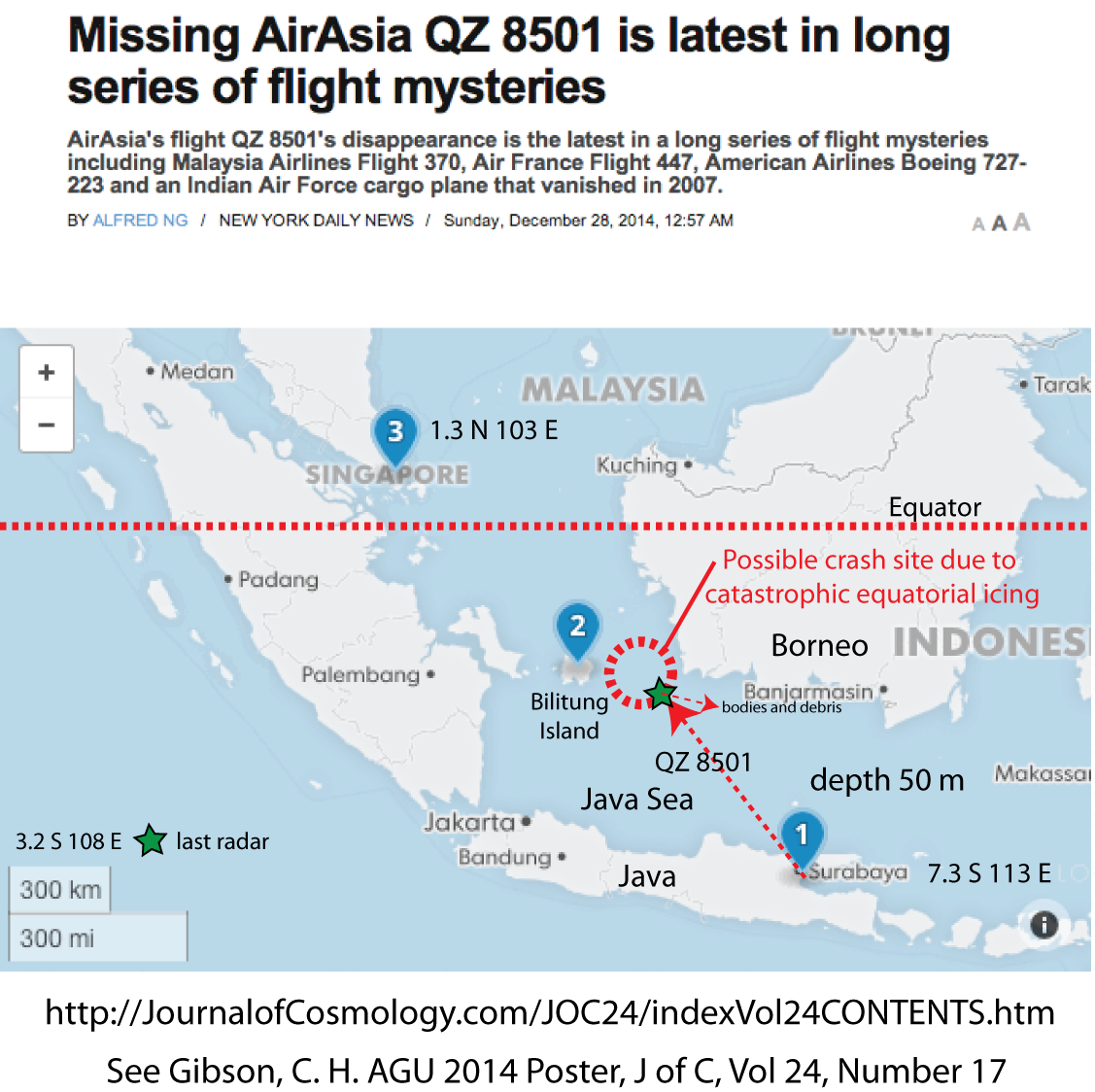
Figure JC2014.24.17.1 CHG: The New York Daily News report Dec. 28, 2014, nicely captures the mysterious, and shocking, nature of CEI events. pp 12331-12332.
Unfortunately, all aspects of the available news reports a few hours after the December 28, 2014, event suggest another catastrophic equatorial icing (CEI) event may account for the suddenly missing AirAsia QZ8501 plane, with 162 people aboard. The plane pilots knew they were in trouble (CEI events begin with ice clogging of pitot tube velocity sensors, autopilot failures, etc.) and were refused permission to increase altitude by ground controllers. A combination of extreme turbulence intermittency at equatorial latitudes and an unusually large supply of Indonesian moist air at the sea surface may have created yet another "flight mystery".
Three days after the CEI event, several bodies have been recovered and claims made that the plane wreckage has been detected on the sea bottom close to where radar contact was lost. No map presented by news media shows the location of the Equator, and no commentary reveals an awareness that flights crossing the Equator are in a state of increasing danger as equatorial sea surface temperatures and equatorial surface winds, and turbulence, increase with global warming. Numerous planes simultaneously passed through the identical intertropical convergence zone weather with QZ8501, showing the extremely intermittent nature of the CEI event that crashed the plane.
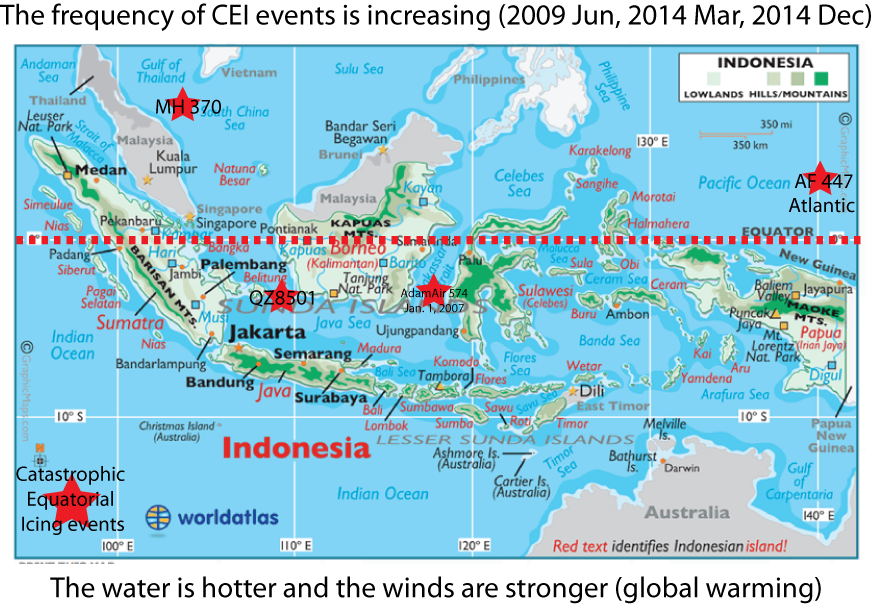
Figure JC2014.24.17.2 CHG: Latitudes of claimed CEI events near the Equator. Adam Air 574 in Jan. 2007 is a strong CEI candidate rather than "Pilot Error", crashing at nearly the same ~ 4 S latitude as the QZ8501 tragedy, and with ~ 90 degree roll angles matching those of AF 447, from the black boxes, consistent with the postulated catastrophic equatorial icing (CEI) phenomenon. pp12329-12330.
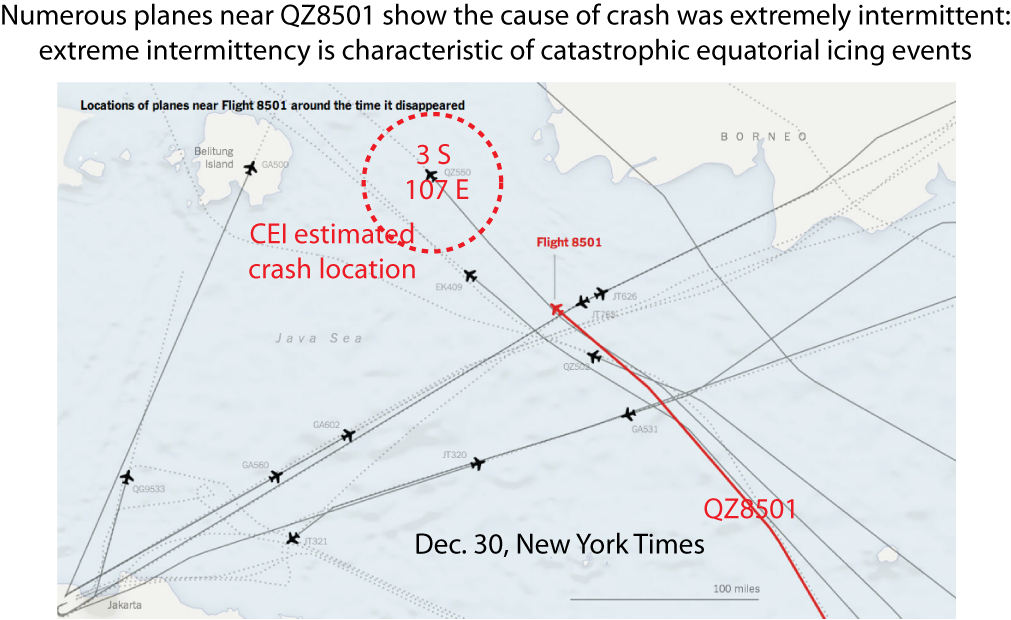
Figure JC2014.24.17.3 CHG: Numerous aircraft are shown passing through the same airspace without accident simultaneously to QZ8501, suggesting the cause of the crash must be more complex than simply "weather" as suggested by officials. pp 12326-12328.
January 3, 2015, news reports suggest sonar has located the plane on the sea bottom, but no location has been reported, CHG. The odds for an equatorially induced CEI event have apparently increased in five years from ~ one in a million to ~ one in a hundred thousand. As with the Adam Air 574 black boxes, the QZ8501 black boxes were recovered within ~ 1 mile of each other, showing that the planes broke up on water impact rather than at altitude.
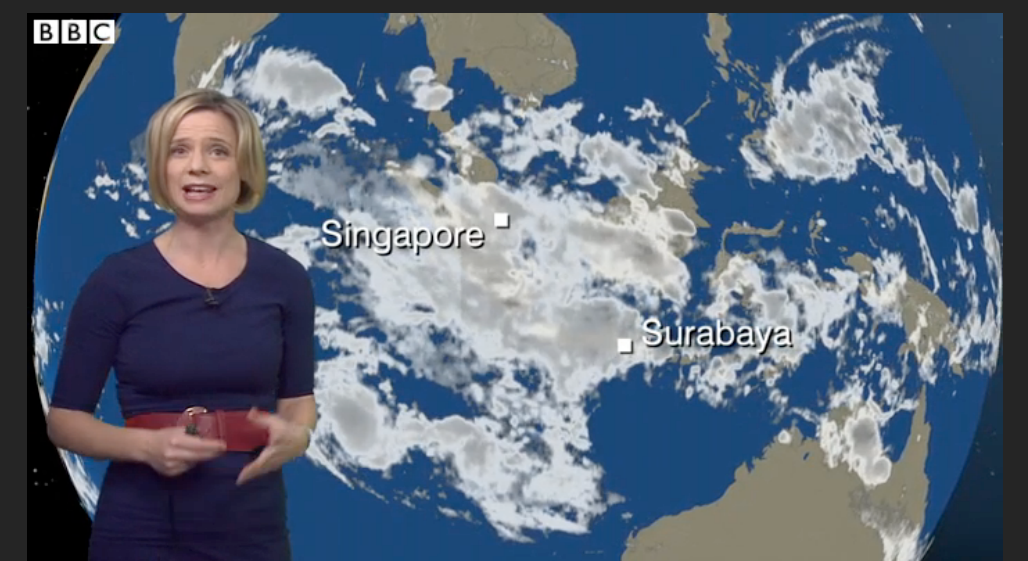
Figure JC2014.24.17.4 CHG: Severe weather conditions Dec. 27-28, 2014, shown by BBC. pp 123323-12325.
A weather map was shown with the initial, day-one, BBC report of the QZ8501 event, showing the eye of a typhoon directly on the flight path line between Surabaya and Singapore, very close to the Equator and with perfect conditions for a catastrophic equatorial icing (CEI) event. Planetary and shear vorticity from the island of Borneo south of the equator can be seen combining in a turbulence cascade capable of producing a rare, but fatal, BZTMA mixing chimney of supercooled steam at aircraft altitudes. The pilot's request to increase altitude is evidence that the pitot tubes were icing over despite heaters designed to prevent this for normal conditions.
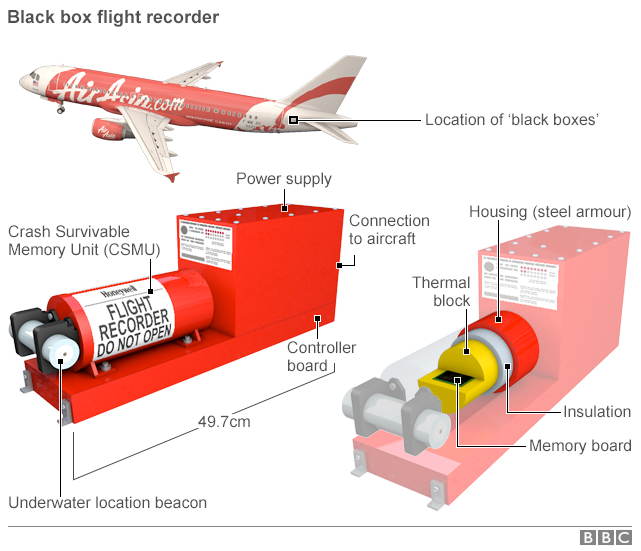
Figure JC2014.24.17.5 CHG: The Flight Data Recorder and Cockpit Voice recorder black boxes are located in the tail section of QZ8501 to prevent damage in a nose on crash. pp 12321-12322.
Claims are made January 7, 2015, that the tail section has been found, yet no pings from the black box flight recorder have been reported. Strong currents and poor visibility prevent divers from direct inspection of the wreakage. Mention is made by officials of the investigation that icing may have been a factor, but nowhere is any mention made of of catastrophic EQUATORIAL icing (CEI) danger, which is almost certainly the explanation for this tragedy, as well as for the MH 370, AF 447 and Adam Air 574 crashes (CHG).
Jan. 13, 2015, both the Flight Data Recorder and the Cabin Voice Recorder "black boxes" have been recovered and are under examination. Hopefully the Adam Air 574 and AF 447 assumption that all such crashes are due to Pilot Error will not be repeated. The red star shows where the black boxes were recovered.
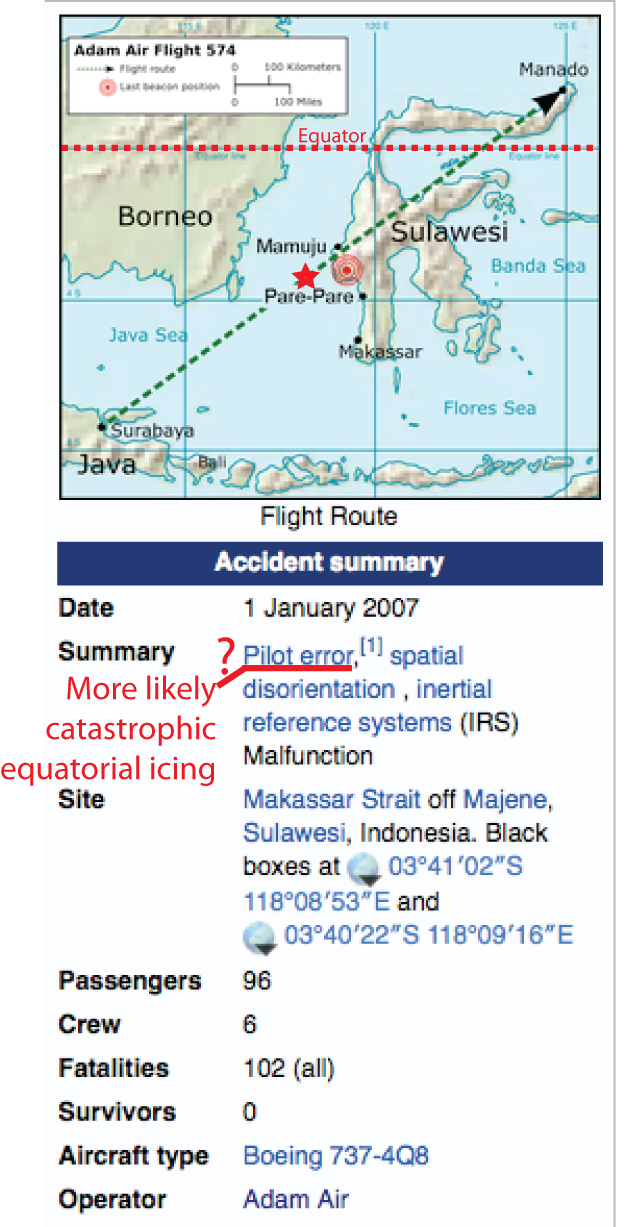
Figure JC2014.24.17.6 CHG: Wikipedia accident summary for Adam Air 574, possibly the first clear example of the catastrophic equatorial icing (CEI) danger, which was not considered in the Accident Summary or in the Air France 447 BEA report that also unfairly blamed the pilots. pp12318-12320.
Vol 24, #22. 1 Signal Magazine will publish a Catastrophic Equatorial Icing event article in its May 2015 Issue.
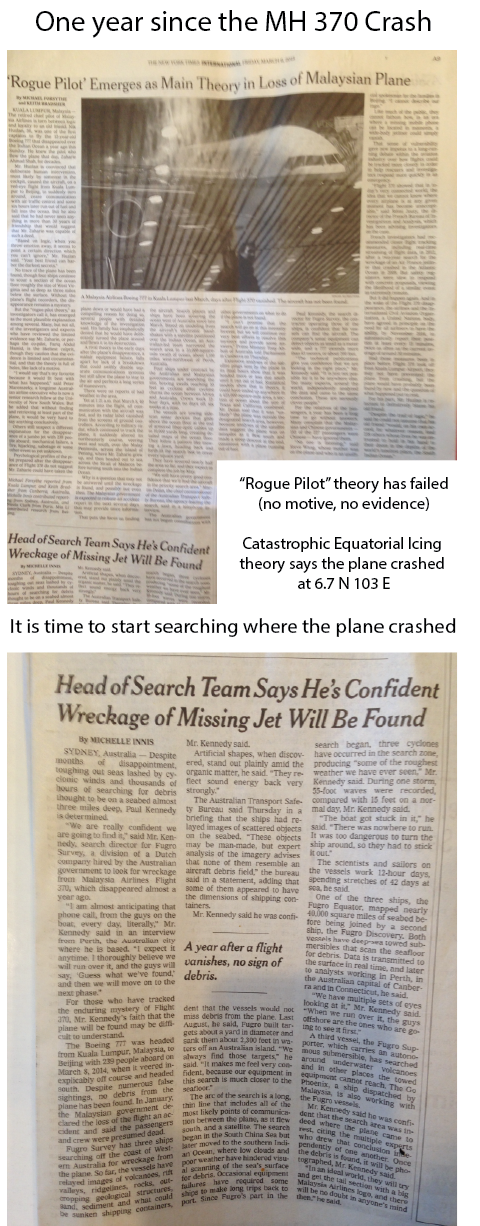
Figure JC2015.24.22.1.1 CHG. The New York Times has marked the one year anniversary of the Malaysian Airlines 370, March 8, 2014, crash with these two articles (top, Rogue Pilots; bottom, Head of Search ...). The heroic search of the South Indian Ocean has only proved the MH 370 plane is not there, and that the "Rogue Pilot" hypothesis is likely false. Instead of searching this remote > 200x200 square mile area in deep water and high seas far from the crash, whiy not explore carefully the smaller < 50x50 square mile area in shallow tropical waters where MH 370 is more probably located? Rule number one in searching for lost objects: always search most carefully
the last place where the object was certainly seen. For MH 370, this was 6.7 N 103 E. pp 12406-12407.
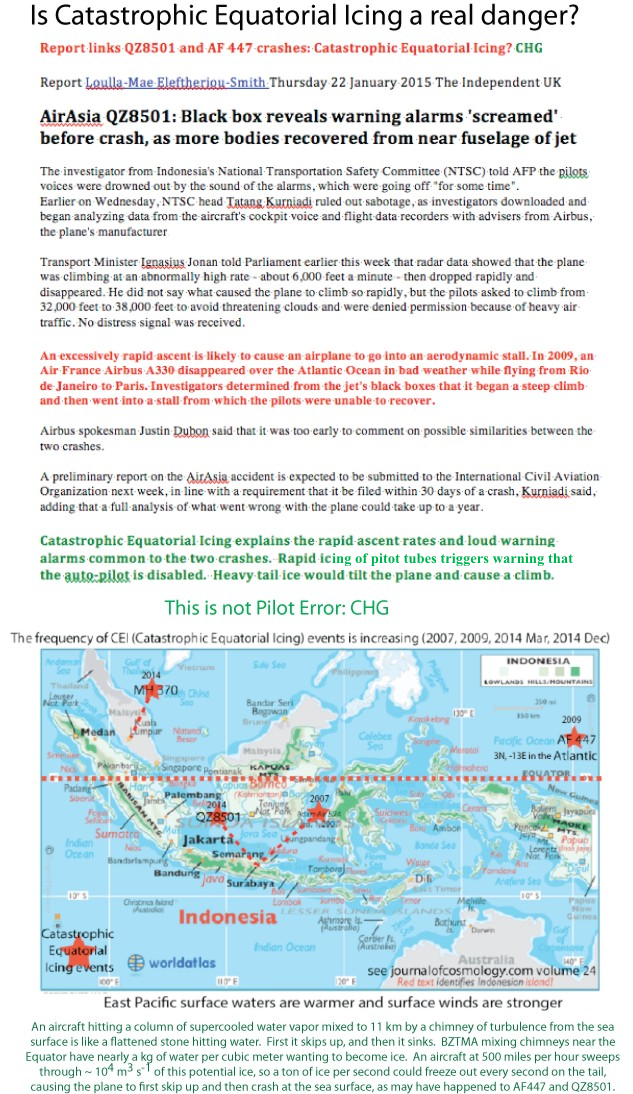
Figure JC2015.24.22.1.2 CHG. New information about QZ8501 reports the plane rapidly ascended before crashing in minutes. Because the QZ8501 pilot had been specifically forbidden to increase his altitude, catastrophic icing and involuntary rapid ascent seems the most likely explanation, and possibly for AF447 that also rapidly ascended just before crashing. If the two planes hit BZTMA mixing chimney columns of supercooled water vapor, their initial rapid ascents would be like flattened stones hitting a water surface: first skipping up and then sinking. Massive tail section icing with simultaneous pitot tube and autopilot failures could result, with loss of most pilot controls except for the power. Neither tragedy should be blamed on pilot errors. Indonesian Transport Minister Ignasias Jonan may have had reliable information about QZ8501 not yet available to the public for his report to the Parliament mentioned in the Independent UK news story.
Vol 24, #21Catastrophic Equatorial Icing events crash aircraft with increasing frequency, Carl H. Gibson, Preprint of contribution for Turbulent Mixing and Beyond 2014 conference in Trieste, Italy, August 2014, pp 12293-12307.
Vol 24, #44. Commented version of "Pilots Face Brick Wall-Like Icing along the Equator", by R. Norris Keeler, Signal Magazine, May 1, 2015. This is the first time any entity of the media (Signal Magazine) has had the courage to publish this scientific idea, based on fluid mechanics, suggested many times in the Journal of Cosmology. As Dr. Keeler points out, this is a freakish aircrft accident mode, caused by unexpected BZTMA turbulent mixing chimneys of supercooled steam, and the lack of horizontal equatorial Coriolis forces that limit turbulence intermittency at higher latitudes, and is NOT PILOT ERROR. Comments are by Carl H. Gibson, titled "Why you should be careful crossing the Equator in an airplane", pp 12704-12708.
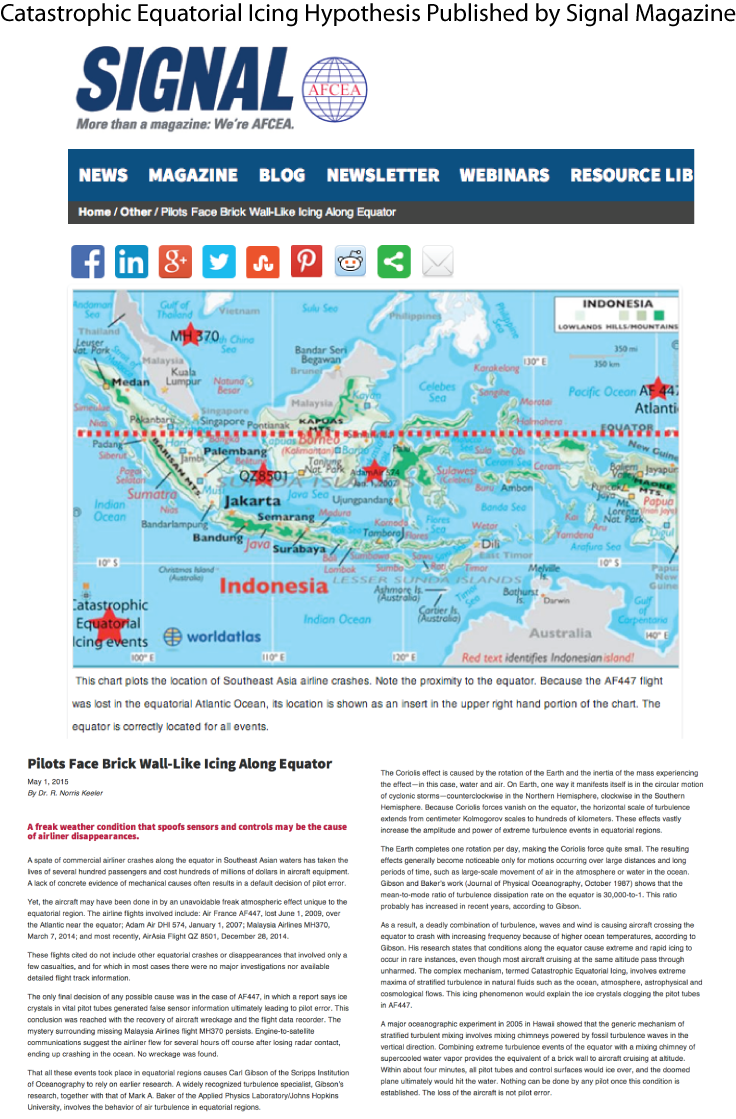
Figure JOC2015.24.44.1 CHG. The MH 370 crash has now been officially declared an accident by Indonesian authorities, suggesting the Pilot-Copilot-Terrorist etc. conspiracy theories leading to the South Indian Ocean search strategy was a very expensive, and heart-rending, mistake. No scientific arguments have been presented by anyone that contradict the Equatorial Icing Event hypothesis. Why has the search not yet moved to the logical location in the shallower waters of the South China Sea where the plane was last seen; that is, at 113 E, 6.7 N? This is strongly recommended from analysis of all available evidence, which suggests more such Equatorial Icing Events will occur if no action is taken to prevent them. pp 12709-12710.
Vol 25, #15. Debris from MH370 crash arrives on Reunion Island, Carl H. Gibson Editorial commentary, pp 13300-13308. Previous reports on the cause of the crash are found in Volumes 21, 22, 23, and 24 of the Journal of Cosmology.
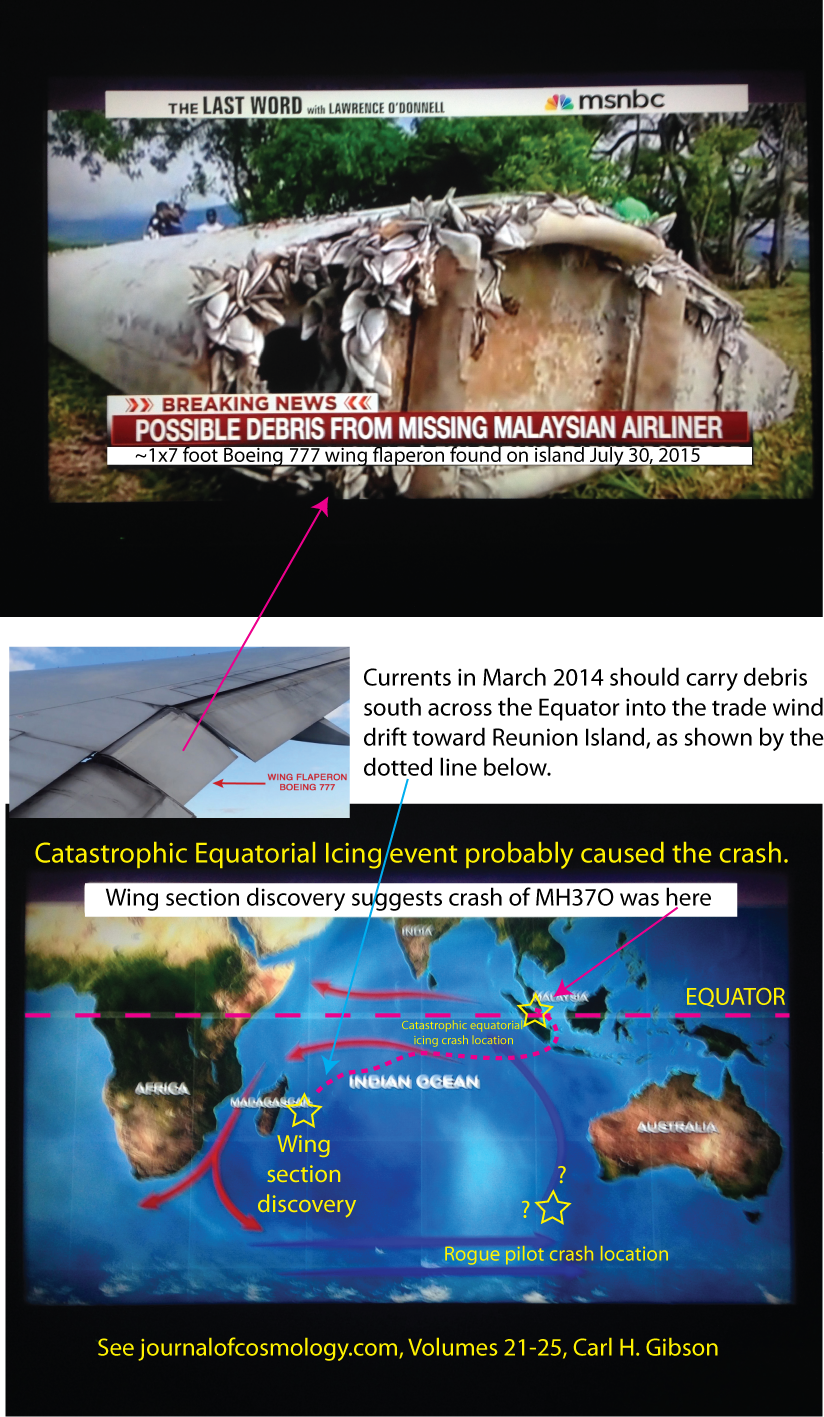
Figure JC2015.15.1 (CHG). pp 13309-13310. First discovery of MH370 debris suggests the crash was due to catastrophic equatorial icing in the South China Sea, not due to "Rogue Pilots" in the South Indian Ocean. Rogue Pilot scenarios are based on unconfirmed and apparently incorrect speculations about the MH370 flight path. See https://JournalofCosmology.com/JOC24/AGUfinal.pdf Gibson Poster at 2014 AGU meeting, San Francisco, CA. The average drift rate from the crash location at 103E 6.7N, where civilian radar contact was lost, would be ~ 30 miles per day along the dotted path shown in Figure JC2015.15.1, South between Sumatra and Java, and West with the trade wind drift to Reunion Island where the Boeing 777 flaperon was discovered (see central inset). No Boeing 777 aircraft are missing other than MH370. The questionable "Rogue Pilot" crash location has remarkably produced no debris anywhere on the coast of Australia, and would require unreasonably high drift rates and directions for the flaperon to appear on Reunion Island so soon. Drifters that replicate the Boeing 777 flaperon should be released in March, 2016 from the two locations shown by yellow stars in the figure to see where they go. Better yet, search the bottom near 103E, 6.7 N to find the rest of the plane. The southern hemisphere western boundary current shown with a question mark is slow, and tends to trap debris in the center of the gyre, not rapidly move it to Reunion Island locations. From this evidence, it is quite impossible that MH370 crashed in the "Rogue Pilot" location shown in the figure off the southwest coast of Australia. The present search should be abandoned, and moved to the Sunda strait for debris and 103 E 6.7 N for the plane.
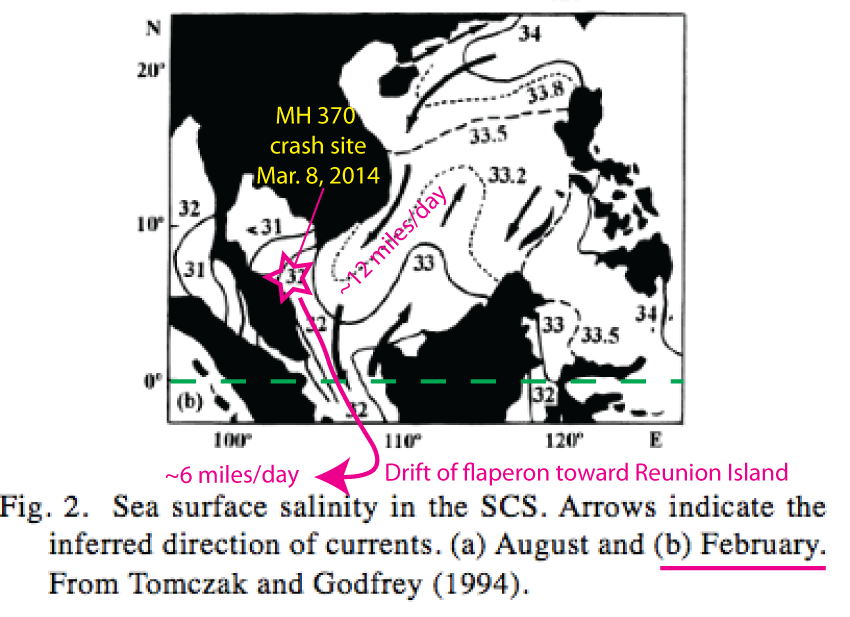
Fig. 2 from "A Review on the Currents in the South China Sea: Seasonal Circulation, South China Sea Warm Current and Kuroshio Intrusion", JIANYU HU, HIROSHI KAWAMURA, HUASHENG HONG and YIQUAN QI, Journal of Oceanography, Vol. 56, pp. 607 to 624, 2000. Commented by Carl H. Gibson, pp 13310-13328. Winter monsoon winds power currents to the south near the crash site at speeds ~ 0.5 kn, or ~ 12 miles/day. This explains why no debris has been found in the Gulf of Thailand to the north, since floating items would be flushed south with the flaperon through the Sunda Strait between Sumatra and Java. The search for debris of MH370 should focus on the Sunda Strait and its many islands. For the flaperon to reach Reunion Island in 115 days requires a drift rate to Sunda Strait faster than the conservative 6 miles/day shown. A trade wind drift rate of ~40 miles/day plus a monsoon drift rate of 15 miles/day is indicated. No scenario permits debris from the Rogue Pilot crash sites near Australia to match this speed, and optimistic scenarios take flaperons from Australia to locations far South of Reunion Island, months or years late.
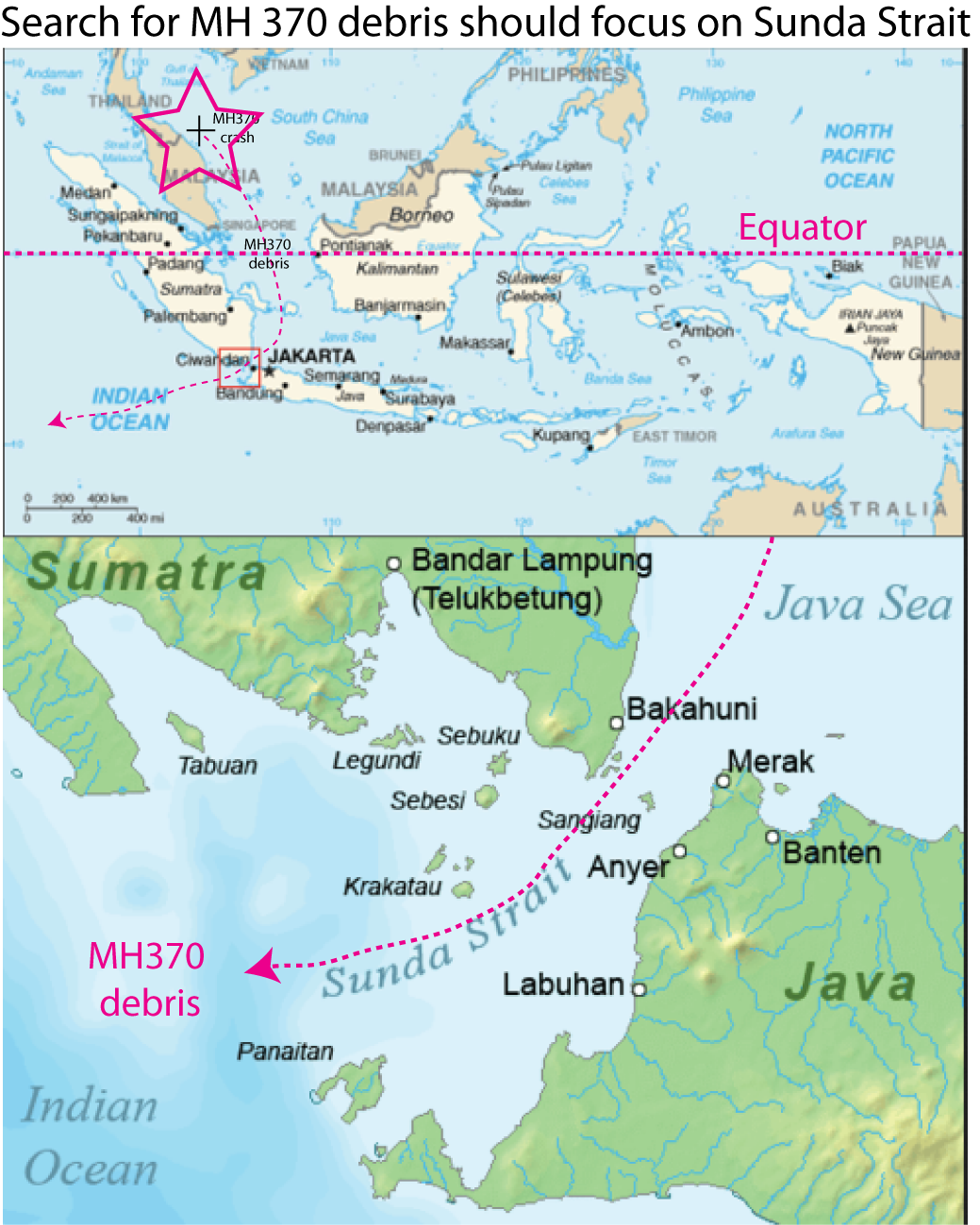
Figure JC2015.15.2 (CHG). pp 13311-13312. Surface currents expected in the South China Sea near the March 8, 2014, date of the crash. Clearly the MH370 crash was in water, not on land as sometimes suggested, and probably with all flaps and flaperons extended to slow the rapid descent of an emergency landing at sea, as expected for a plane suddenly brought down by a Catastrophic Equatorial Icing event.
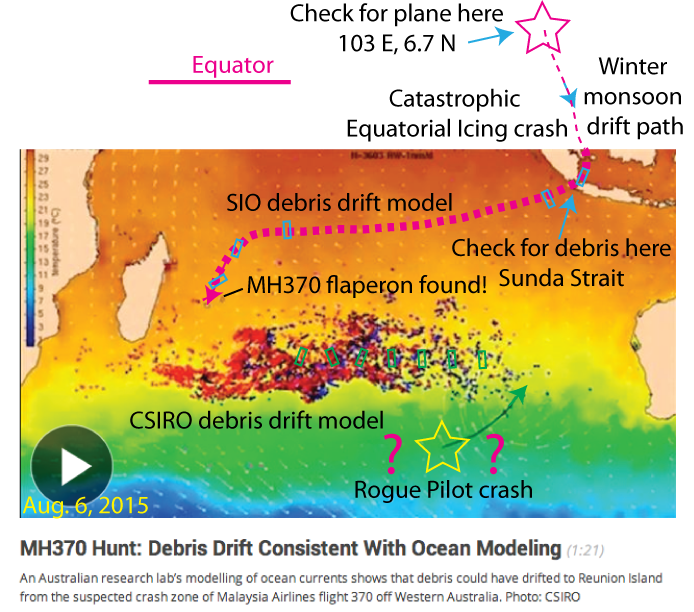
Figure JC2015.15.3 (CHG). pp 13314-13316. The Malaysian Prime Minister Najib Razak and the French investigating team agree that a MH370 flaperon has been discovered on Reunion Island. The question and mystery is how it got there. The answer proposed by Carl H. Gibson (Professor of Engineering Physics and Oceanography at MAE, SIO and UCSD) is that the plane crashed March 8, 2014, at 103 E, 6.7 N due to Catastrophic Equatorial Icing, and that more such tragic crashes will occur until this phenomenon is recognized by the scientific community and the authorities controlling commercial aircraft, and steps are taken to avoid it. The CSIRO debris drift model shows the MH370 flaperons (green) have zero chance of arrival on Reunion Island from the Rogue Pilot crash location. If instead of the thousands of debris particles shown, only a few flaperons were modelled, CSIRO would show them ~ 1000 miles South-East of Reunion island moving slowly West toward the coast of Africa. This rules out the "Rogue Pilot" crash hypothesis in favor of the Gibson-Keeler Catastrophic Equatorial Icing event scenario that has also tragically claimed AF447, Adams Air 574, and Air Asia QZ8501 with loss of all lives on board.
Vol 25, #26Catastrophic Equatorial Icing May be Crashing Airplanes, Carl H. Gibson Applied Ocean Sciences Seminar, October 1, 2015, 4 pm, Spiess 330, SIO, UCSD, pp 13453-13481.
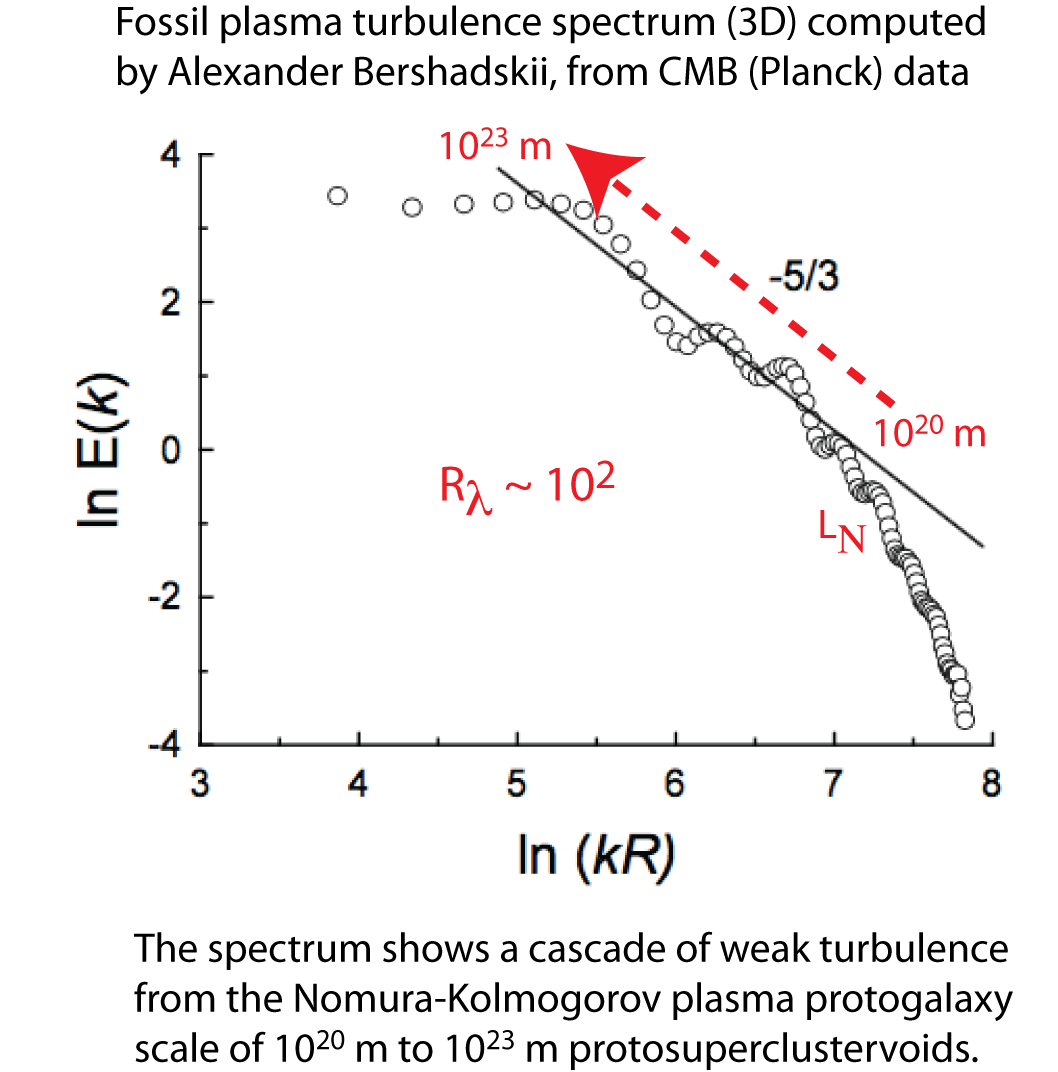
Figure JC2015.26.1 (Carl H. Gibson) "Universal Kolmogorov Similarity of Turbulence During the Plasma Epoch". Alexander Bershadskii (personal communication) has calculated a 3D velocity power spectrum from archived Cosmic Microwave Background (CMB) data, rather than the usual spherical harmonics, and it fits very well to the spectral form obtained from terrestrial observations. The -5/3 inertial subrange is that predicted by the second universal similarity hypothesis of Kolmogorov-Obukhov for weak turbulence (R_lambda ~ 10^2), starting at the Kolmogorov-Nomura scale of 10^20 meters, matching the HGD kinematic viscosity ~ 10^-26 m^2 s^-1 for fragmentation of plasma protogalaxies at time 10^12 s when fragmentation of the plasma began. The density ~ 10^-17 kg/m^3 existing at that time matches the density of all globular star clusters and all protoglobularstarclusters. The red arrow shows the cascade of the fossil plasma turbulence from small protogalaxy scales to large protogalaxycluster scales from HGD cosmology, falsifying inviscid, collisionless LCDMHC cosmology. Linear chain clusters of galaxies such as the Stephan Quintet and the Hickson compact groups demonstrate the stretching of plasma epoch vortex lines triggering protogalaxy fragmentation along the lines. pp 13490-13498.
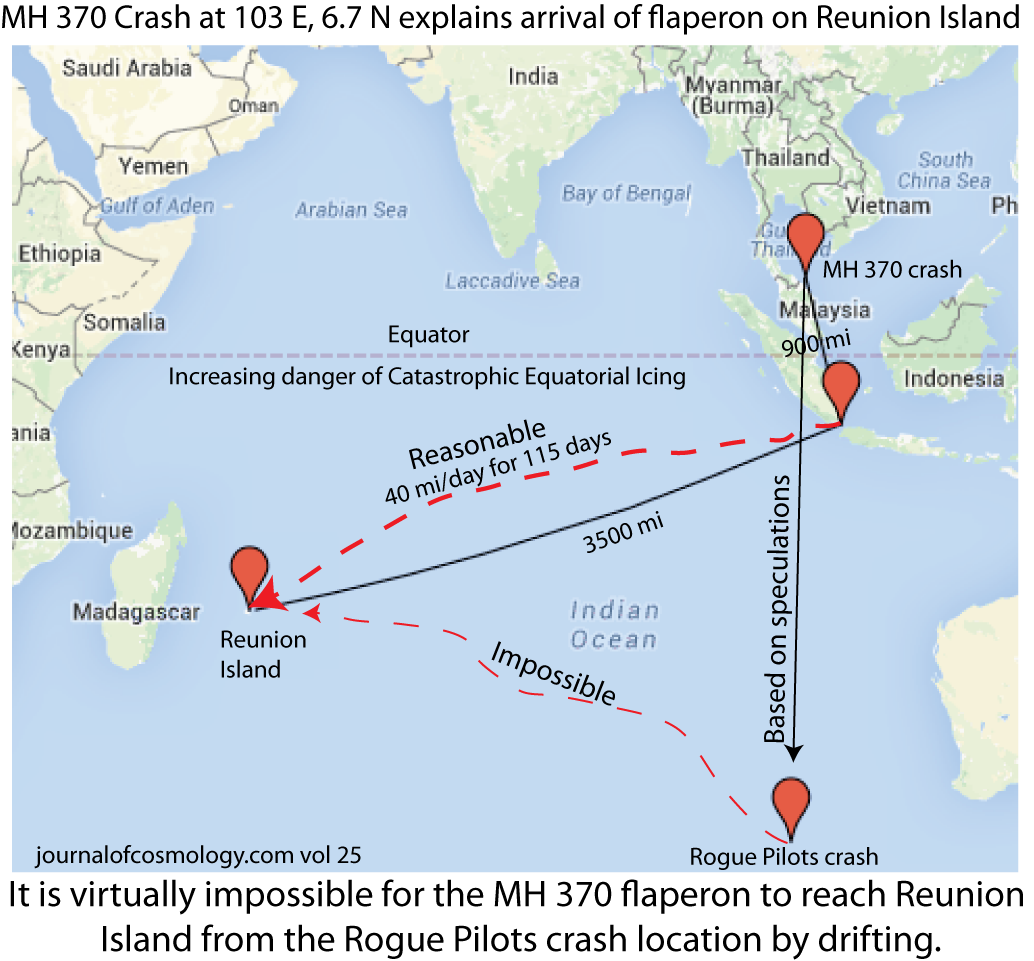
Figure JC2015.26.2 (Carl H. Gibson) "Flaperon Drift rate estimates support the hypothesis that MH 370 crashed in the South China Sea, not the South Indian Ocean". Drift path estimates for the MH370 flaperon from the last civilian radar (103 E, 6.7 N Mar. 8, 2014) confirmed location give a reasonable scenario to arrive at Reunion Island in 115 days. An average drift speed of about 40 miles/day is required to cover > 4400 miles in this time. Possibly slower speeds 900 miles south to the Sunda Strait from the winter monsoon are compensated by higher speeds west in the trade wind drift. No scenario could be found to move a flaperon from the South
Indian Ocean search locations, all of which assume unconfirmed Rogue Pilots crash speculations (see discussion in JofC, Vol. 23, No. 18). There is no solid evidence that "The plane turns off course and heads west" as reported by CBS and others as a fact. The military radar operators were asked to look for a missing plane based on a cockpit computer setting of unknown purpose, cause, or history. No plane responded that it was MH370, pp 13490-13494. A CBS report about MH370 reveals confusion about the MH370 flaperon drift path and date of arrival (Carl H. Gibson Editorial Comment), pp 13482-13488. The time of passage is not 18 months as assumed in this report, but less than 4. Note that the trade wind speed of Christopher Columbus in his thirty day 1492 voyage of discovery, 3727 miles between the Canary Islands and the Bahamas, was at only 124 miles/day under sail.
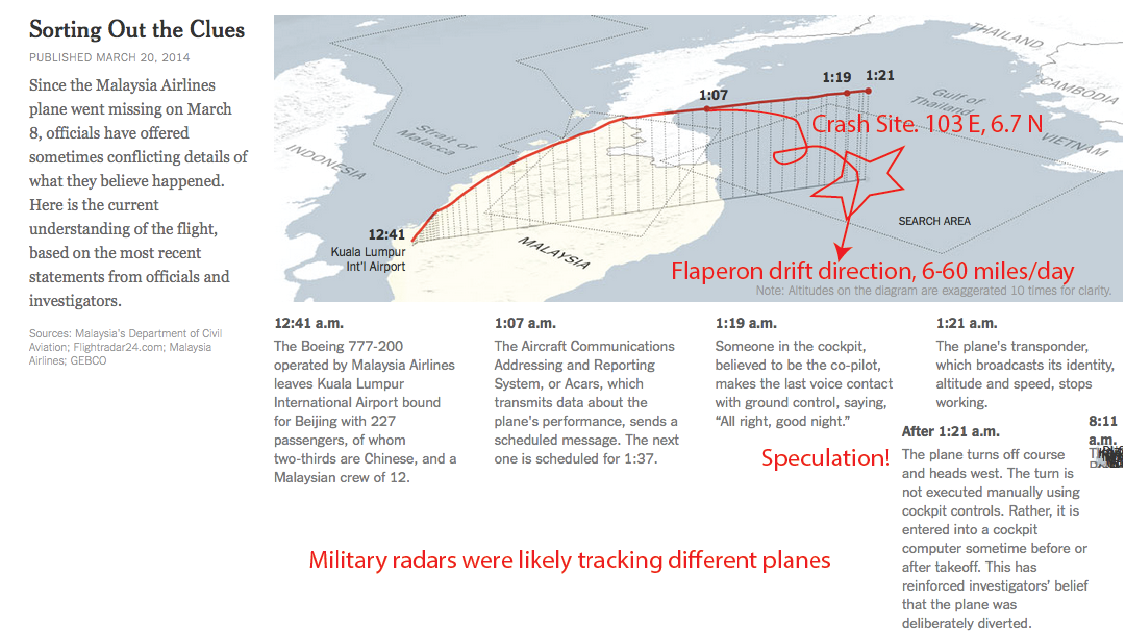
Figure JC2015.26.3 (Carl H. Gibson). Information given to operators of military radars March 8, 2014, that MH370 was going west was based on the speculation that this direction had been preprogrammed into the cockpit computer by Rogue Pilots, and the speculation that the plane was actually going this way (rather than crashed by catastrophic equatorial icing at the red star location). This possibility is supported by the arrival of the flaperon on Reunion Island only 115 days later. This high speed drift (40 miles per day) suggests the flaperon drift direction must have been south at the upper end of the 6-60 miles per day speed range estimates shown.
Vol 25, #37. Turbulence at the Equator causes maximum mixing and maximum confusion. Commentary on "Mixing With Lattitude", Garrett, Nature (2003), Carl H. Gibson, pp 13664-13666.
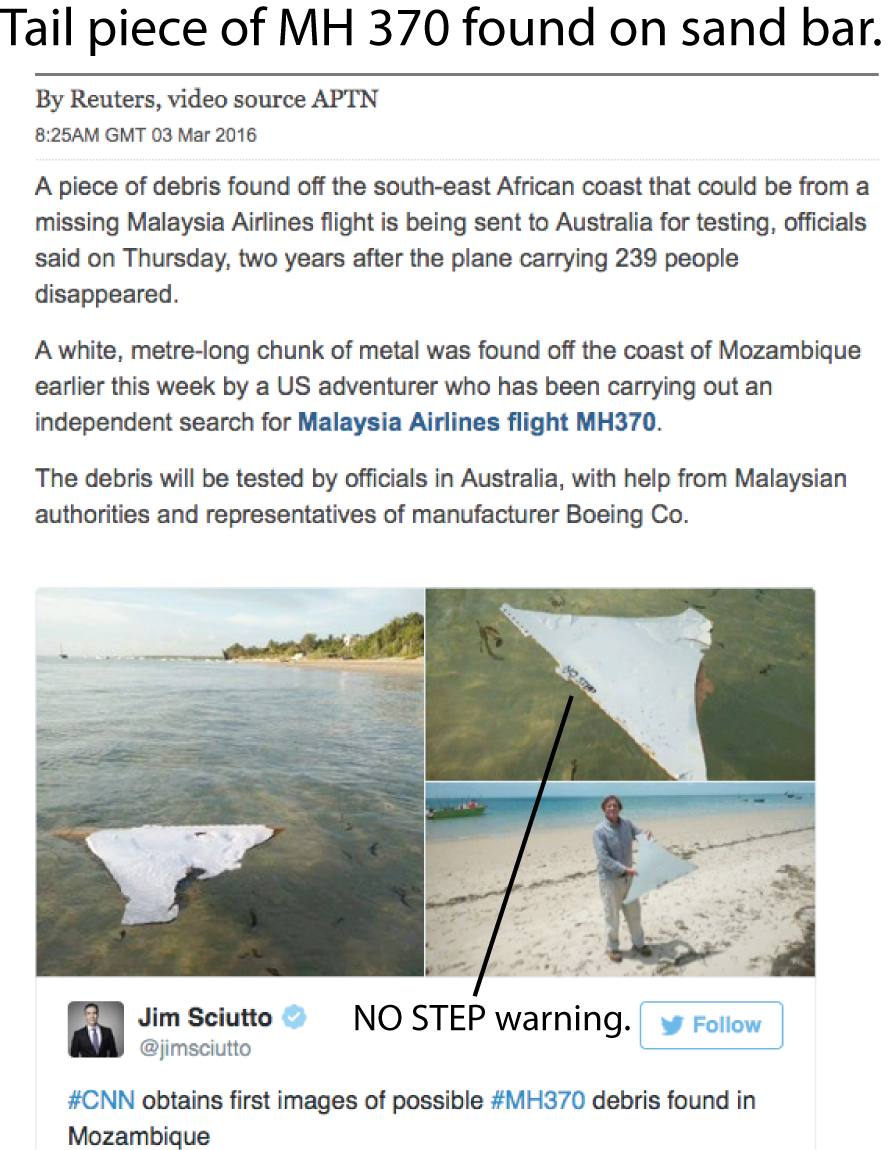
Figure JC2016.37.1 shows that ignorance of turbulence and stratified turbulent mixing processes, manifest in the Garrett (2003) and Gregg (2003) papers, can be deadly. How many more Catastrophic Equatorial Icing tragedies such as MH 370 and AF 447 must occur to prove this fact?
Figure JC2015.26.2 shows the location of the sand bar in the Mozambique channel. From the New York Times, Mar. 3, 2016, an unidentified "Authority" suggests the "object" is from the fixed forward edge of the MH 370 right horizontal stabilizer. Neither this debris nor the flaperon could possibly originate where the present "rogue pilot" search effort is going on. The search for MH 370 should be shifted immediately to the South China sea, near 103 E 6.7 N where the plane was last seen.
Figure JC2015.26.3 shows another likely fragment of MH370 recovered in December, 2015 by an 18 year old South African tourist on a Mozambique channel beach, according to CNN. See the link https://edition.cnn.com/2016/03/11/africa/mh370-mozambique-possible-debris/index.html for more information. It is quite impossible that this fragment came from the south Indian ocean where the nonsensical search is presently continuing based on "rogue pilot" speculations.
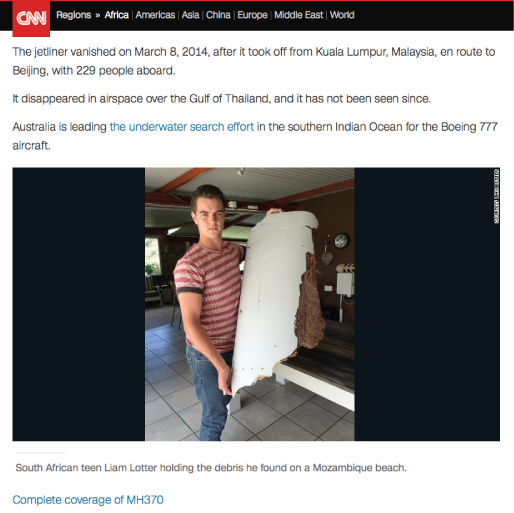
Vol 25, #38. Turbulence measurements at the Equator are vastly undersampled. Commentary on "Reduced mixing from the breaking of internal waves in equatorial waters", Gregg et al., Nature (2003), Carl H. Gibson, pp 13667-13670.
Figure JC2016.38.1 shows the route (in red) of MH370 based on speculations that it crashed from pilot conspiracies or errors rather than a Catastrophic Equatorial Icing event. The exhaustive search in the south Indian ocean proves that these unfounded media speculations were wrong, and the southern ocean searches were, and still are, a waste of time and money, since MH 370 and its 239 victims are waiting to be found where they were last seen at position 2, in the south China sea. The search for MH 370 should be immediately moved to this location. The media had no reliable help from the scientific community due to deadly ignorance of how extremely intermittent turbulence and vertical turbulent mixing of supercooled water vapor can work near the equator. Papers like Gregg et al (2003) and Garrett (2003) are very damaging.
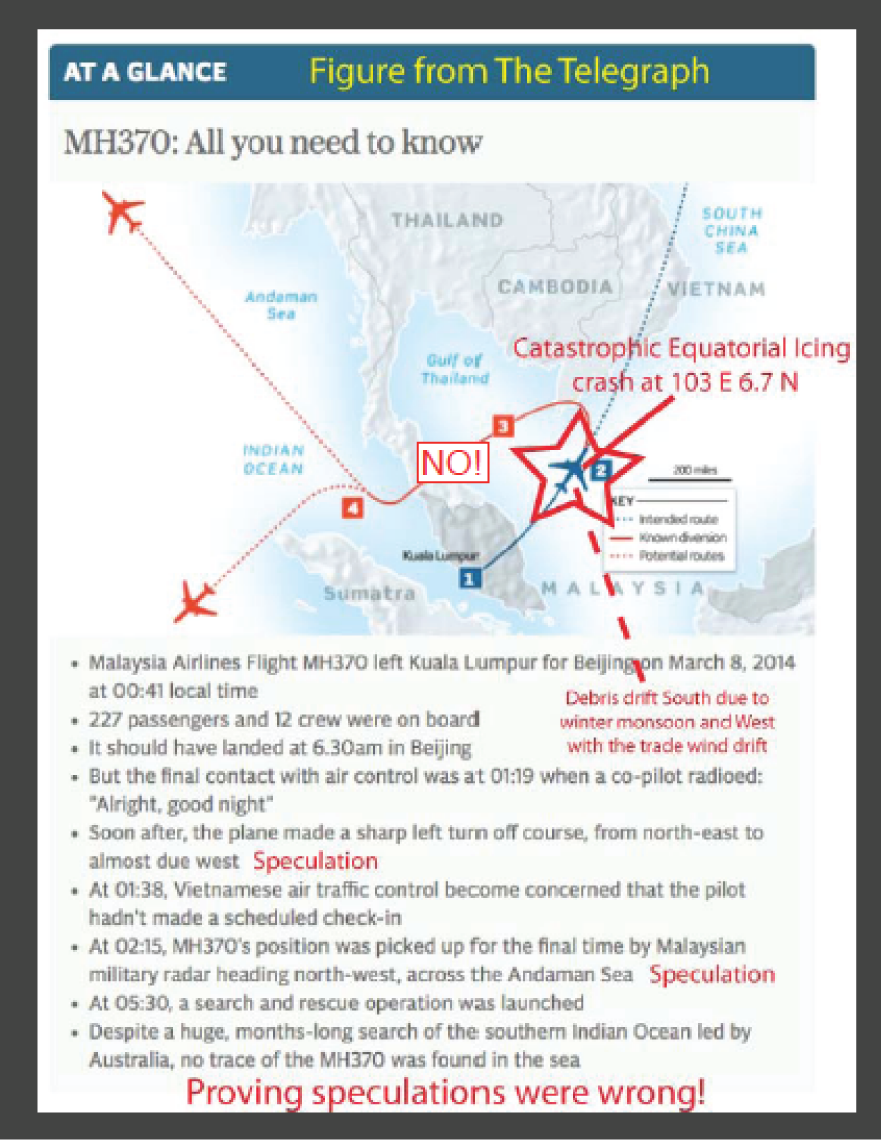
Respected News outlets such as The Telegraph still report the "rogue pilot" route of MH 370 as though it were an established fact rather than unfounded media speculations and faulty fluid mechanics.
Vol 25, #45. Catastrophic Equatorial Icing events Crash Aircraft with Increasing Frequency, Carl H. Gibson, Turbulent Mixing and Beyond 2014, Workshop in Trieste, Italy, updated June 5, 2016, following comments of Referees. pp 13787-13794.
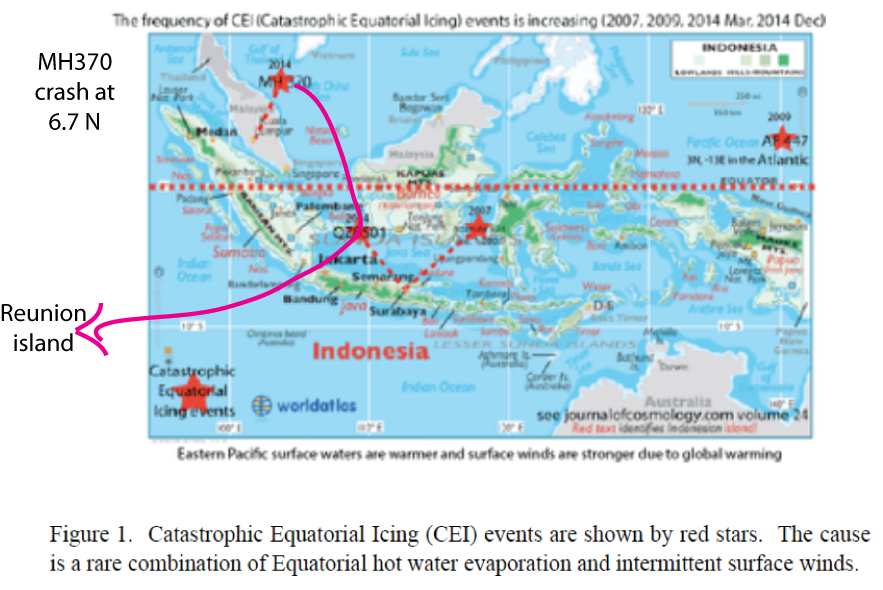
Figure JC2016.45.1 showing the path of MH370 debris after its tragic Mar. 8, 2014 crash. The rapid transit of debris fragments to Reunion island rules out any possibility that the crash could have occured in the south Indian ocean at high southern latitudes > 30 S. The search area should immediately be shifted to the south China sea location at 6.7 N. Crashes such as Egypt Air 804 at > 30 N (Cairo) are better candidates for foul play, p 13795.
Figure JC2016.45.2 features two AAAS/PD 2016 talks by Carl H. Gibson on turbulence and its applications to the ocean and cosmology. Talk 1 "Testing Kolmogorov on Russian Ships". The RASP experiments described are recognized as the most careful test of anti-submarine-warfare (ASW) physics ever carried out. Talk 2 provides proof of the claim "Finally, The Solution of the Turbulence Problem", as well as proof that intermittent BZTMA mixing chimneys of supercooled steam exist near the Equator and are increasingly dangerous with global warming, pp 13796-13804.
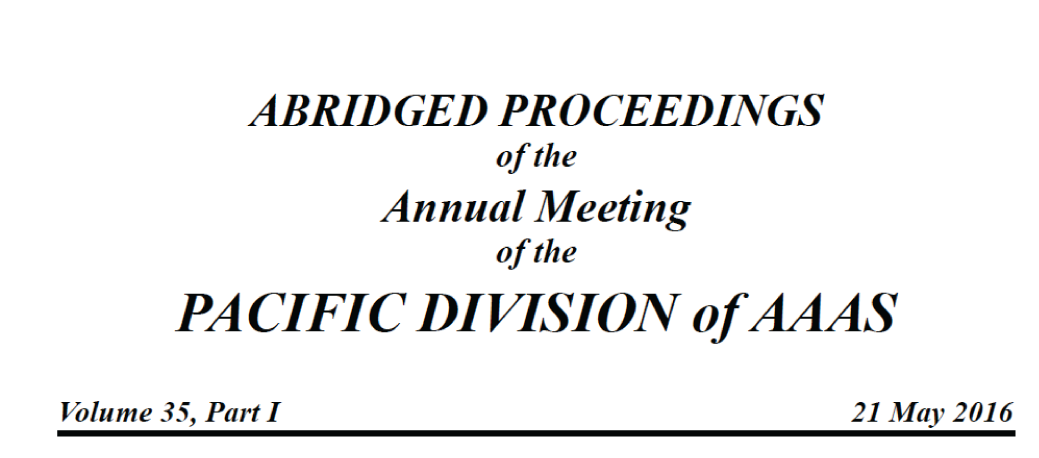
Vol 26, #3.1. How does the mass of a proton arise in HGD cosmology? Commentary by Carl H. Gibson on Temple, JofC 2016, Vol. 26, No. 3.1, pp 13993-13994.
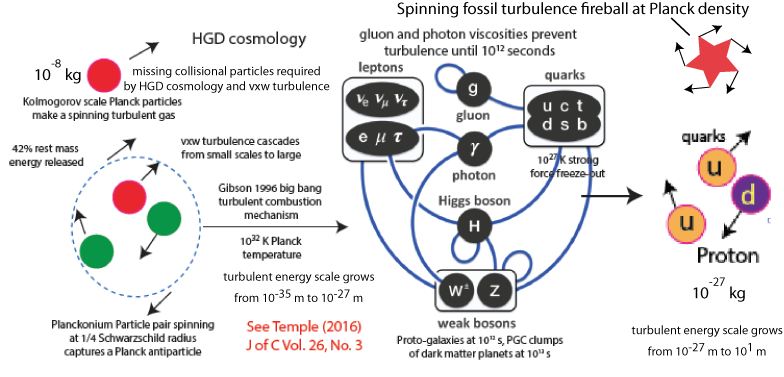
Figure JC2016.3.1.1 Shows a path to the existence of protons from Hydro-Gravitational Dynamics HGD cosmology, Gibson (1996). On the left, Planck temperatures of 10^32 K are achieved from a big crunch event, so only Planck particles (red) and Planck antiparticles (green) can exist. Both have mass 10^-8 kg from dimensional analysis using c, h, and G, compared to 10^-27 kg for a proton, where c is the speed of light, h is Planck's constant, and G is Newton's constant. The Planck temperature can be derived by including the Boltzmann constant k. A gas of Kolmogorov scale Planck particles becomes turbulent because the Planckonium pair accretes a Planck antiparticle so the Planck particle gas will become turbulent by collisional fluid mechanics. The Taylor microscale Reynolds number of the flow is well above critical at ~ 10^3. Inertial vortex forces vxw of local Planck particle jets create negative pressures < -10^-113 Pa sufficient to extract mass energy from the vacuum, powering inflation and the exponential expansion of the universe. A spinning fossil turbulence fireball results, shown as a red star No model has included magnetic monopoles, which are intermediate in mass between Planck particles and protons and seem ideal components of a spinning "black hole" MECO. Protons are uud quark triplets. Neutrons are ddu quark triplets. Both are created in 10^2 s after the "big bang" turbulence event stretched and extended by a turbulent gluon-viscous inflation. The universe is born powered by inertial vortex force turbulence. Photon-electron viscosity prevents turbulence until ~ 10^12 s when 10^20 m protogalaxies fragment along fossil big bang turbulence vortex lines. Many non-baryonic dark matter particles like neutrinos diffuse to much larger scales than galaxies. Dark matter planets in Jeans mass clumps of a trillion begin star formation at 10^13 seconds, not 10^16 s when it is too cold for life formation. Black hole, dark energy, and cold dark matter concepts are not needed, p 13951.
Figure JC2016.3.1.2 Shows the recently measured Higgs boson mass (CERN) is more than a hundred times that of a proton. Therefore we see that Higgs bosons are the likely source of the dominant non-baryonic dark matter and are produced by PAP jets of the first MECOs during inflation, Figure JC2016.26.3.4.1. Planck particles and Planck antiparticles are still missing from the standard particle physics list of subatomic particles, but are crucial to providing the physical basis for the big bang as a turbulent combustion instability, Gibson (2014). p 13952.
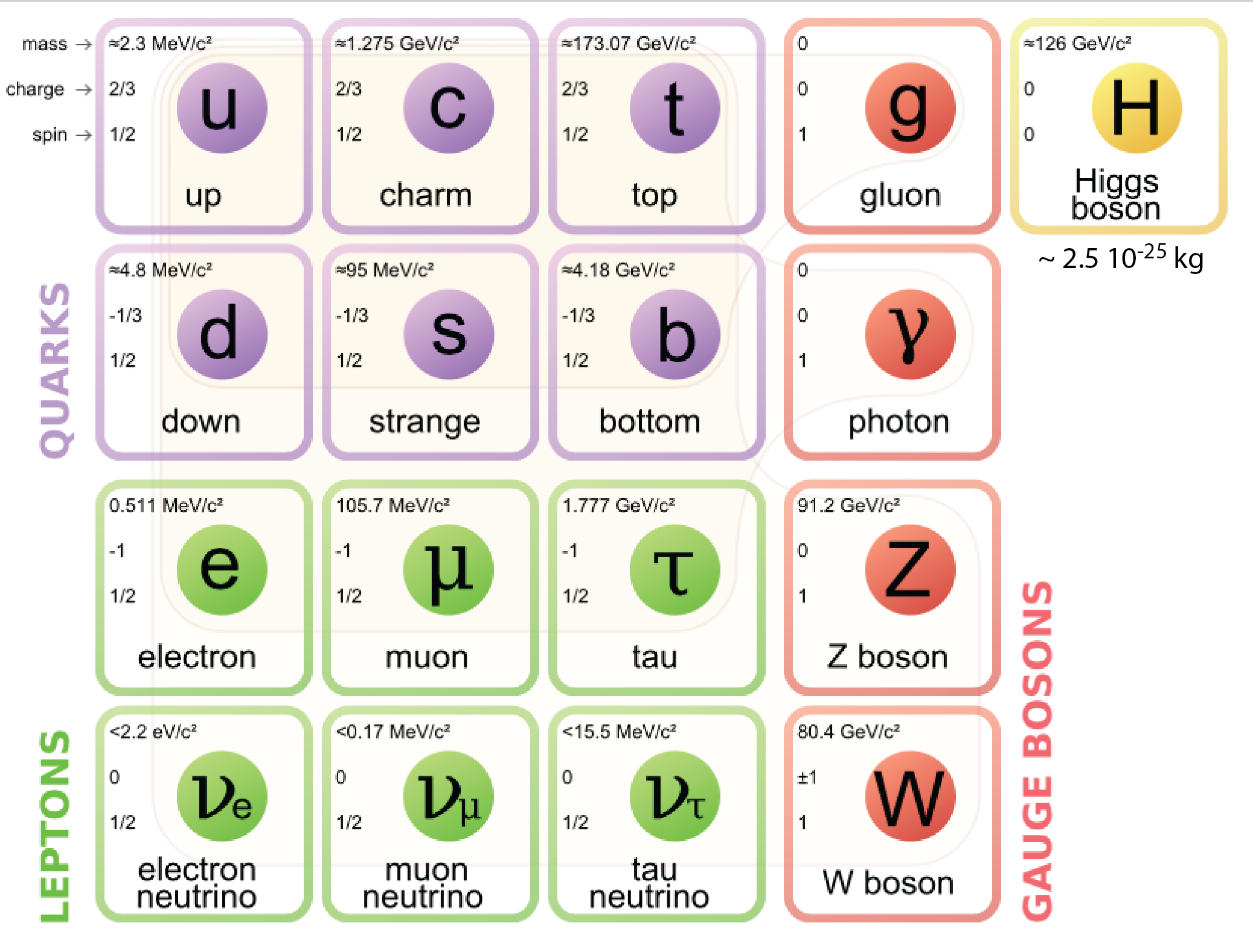
Most of the ~ 10^-27 kg mass of the proton (99%) is binding energy, not quark mass. This suggests the possibility of powerful sub-quark scale inertial vortex force turbulence, which is presently not included in quantum-chromo-dynamics (QCD) theory.
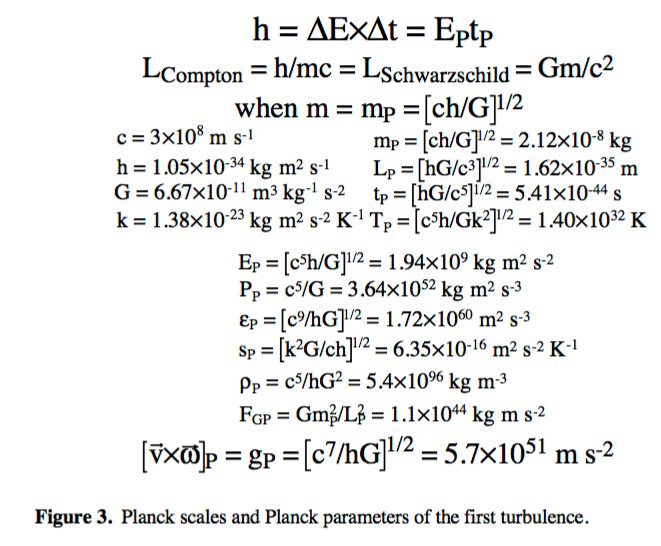
From Gibson 2014.
Figure JC2016.26.3.1.3 Planck conditions are those where the Schwarzschild radius of general relativity exactly matches the Compton wavelength of quantum mechanics. HGD cosmology requires a series of turbulent combustion hot big bangs that create local universes in the vacuum, and hot big crunches where the mass-energy created fall back due to gravity to start the next cycle. It is assumed that the laws of nature (c,h,G,k) in each universe are identical, so each cycle has a 50% chance of being matter dominated or antimatter dominated. As shown in Fig. JC2016.26.3.1, collisional fluid mechanics and inertial vortex forces are critical at every stage to balance gravity. p 13953.
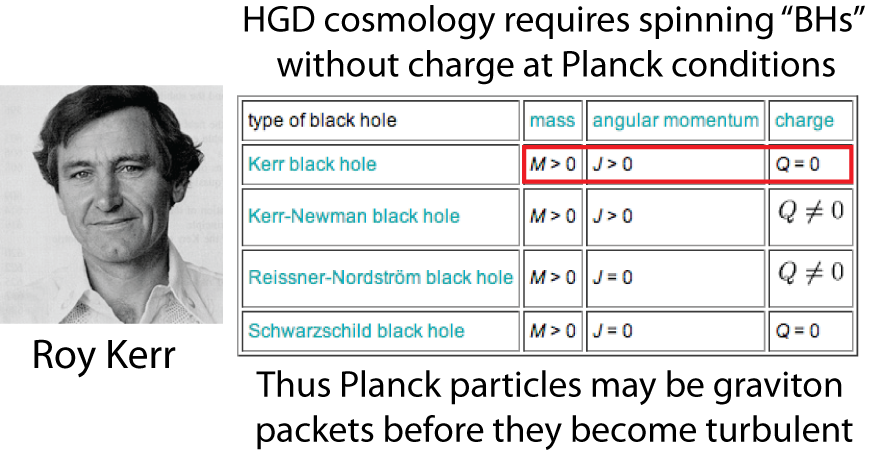
Figure JC2016.26.3.1.4 lists the variety of "black hole" candidates. Kerr black holes are intrinsically spinning, which distorts space-time at small scales in general relativity. Gravitons have the largest spin of any fundamental particle, with J = 2. The spinning Kerr "black holes" without charge in the red box are interpreted as graviton packets forming Planck particle and antiparticle "proto-MECOs" in a turbulent transition at the Kolmogorov-Planck scale 10^-35 m. These "micro-MECOs" have no electric charge from electrons because electrons and positrons cannot exist at Planck temperatures 10^32 K. As shown in the figure JC2016.26.3.4.1,
charged Protons (+) and antiprotons (-) combine with magnetic monopole pairs to produce the first MECO, assisted by graviton turbulence and Higgs bosons to produce the signature MECO plasma jet normal to the spin axis. Gravitons have recently been proven to exist by successful LIGO experiments, showing powerful graviton signals emininating from merging "black holes" (B. P. Abbot et al 2016, PRL, 061102) Commented by CHG, favoring a MECO rather than black hole model of the source. No tests were done for graviton turbulence, p 13954.
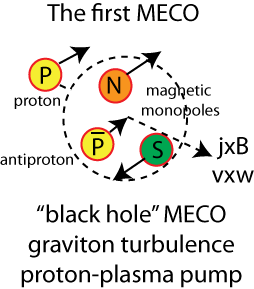
Figure JC2016.26.3.1.4.1 The first MECO. Magnetic monopoles and turbulent proton-antiproton plasma can form turbulent "black hole" MECOs. The plane of the spinning Kerr-Newman black hole (dashed circle) gets its negative electric charge from the antiproton Pbar and its large magnetic moment and strong magnetic field B from the spinning N-S magnetic monopoles ("monopolium": similar to "positronium" electron-positron particle pairs formed in Supernova II events and "planckonium" Planck particle pairs shown in Figure JC2016.3.1). Gravity powers the radial electric current j. The structure pumps (P-Pbar)
proton-antiproton-plasma along the dashed arrow direction normal to the spin plane by jxB electo-magnetic forces of the magnetic monopole pair, adding to vxw inertial vortex forces of turbulent gravitons that provide the turbulence spin, thus causing the inflation of the universe by this nonlinear, turbulent combustion, exponential growth of mass-energy. Alan Guth showed magnetic monopoles appear during the hot big bang with mass (~ 10^-10 kg), larger than protons (10^-27 kg) but less than the Planck mass (10^-8 kg), but did not show the physical mechanism of mass-energy creation by graviton turbulence and electromagnetic forces from spinning monopoles and the resulting turbulent
MECO proton-antiproton-plasma PAP jet. This graviton turbulent "first MECO" model replaces the non-turbulent models that won the 2014 Kavli prize for Alan Guth, Andrei Linde and Alexei Starobinsky from their pioneering studies of the exponential inflation of the Universe needed to explain the big bang. Clearly most of the missing mass-energy (~99%) will be nonbaryonic and electrically neutral. The baryonic missing mass (~99%) is mostly stored as QCD (quantum cromodynamics) internal energy of the PAP. The PAP jet ejected by the magnetic monopole MECO extracts mass-energy from the vacuum to power
inflation. Collisional fluid mechanics and stratified turbulence mechanics cannot be neglected. Turbulence vxw and electromagnetic jxB stresses must exceed negative ~10^113 Pa magnitudes to extract mass-energy and Higgs bosons from the vacuum during inflation (Fortov). Inertial vortex forces of adjacent MECOs and their turbulent vortex lines cause them to merge, which is the key mechanism of the turbulence cascade from small scales to large (Gibson). The big bang and the inflation of the universe are the result of stratified turbulence and turbulent combustion cascades from small scales to large. An excellent discussion "The search for magnetic monopoles" is
given in the Physics Today cover story, October 2, 2016, Vol. 69, issue 10. pp 13955-13956.
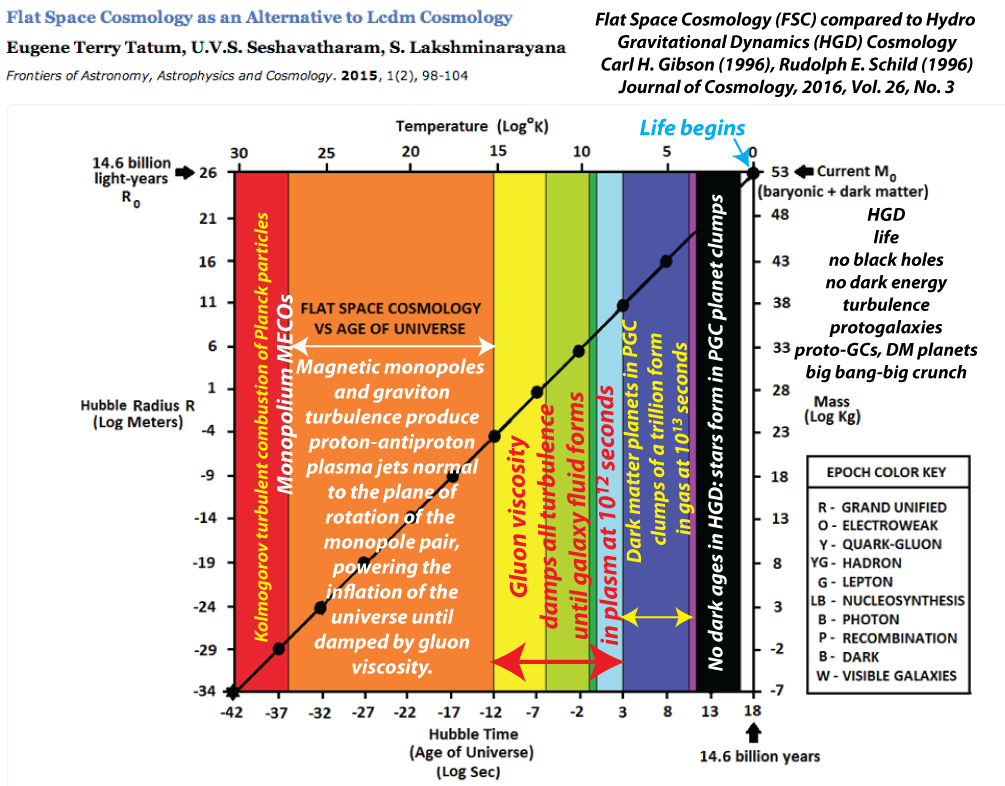
Figure JC2016.26.3.1.4.2 Compares HGD cosmology with Tatum et al. 2015 flat space cosmology (FSC). Both HGD and FSC agree that LCDMHC cosmology is misleading and obsolete (see claims of a similar swindle). FSC cannot detect the important effects of MECOs because it lacks turbulence, kinematic viscosity, and other aspects of collisional fluid mechanics missing from cosmologies other than HGD, such as the formation of life on dark matter planets when water condenses at ~ 10^14 s and 373 K. pp 13994-13995.
Figure JC2016.26.3.4.3 Compares the famous Harvard Hertzsprung-Russell diagram (HRD ~1911) with the predictions of HGD cosmology about star formation. According to LCDMHC cosmology, stars can have up to millions of times the mass of the sun. According to HGD, the limit to star mass is ~ 1.4 solar, ( ~ 10^31 kg), since all stars observed grow by a sequence of dark matter planet mergers within the star's PGC, where carbon stars explode (SN1a events) at the Chandrasekhar limit and iron-nickel core stars explode (SN2 events) at ~ 1.3 solar mass.
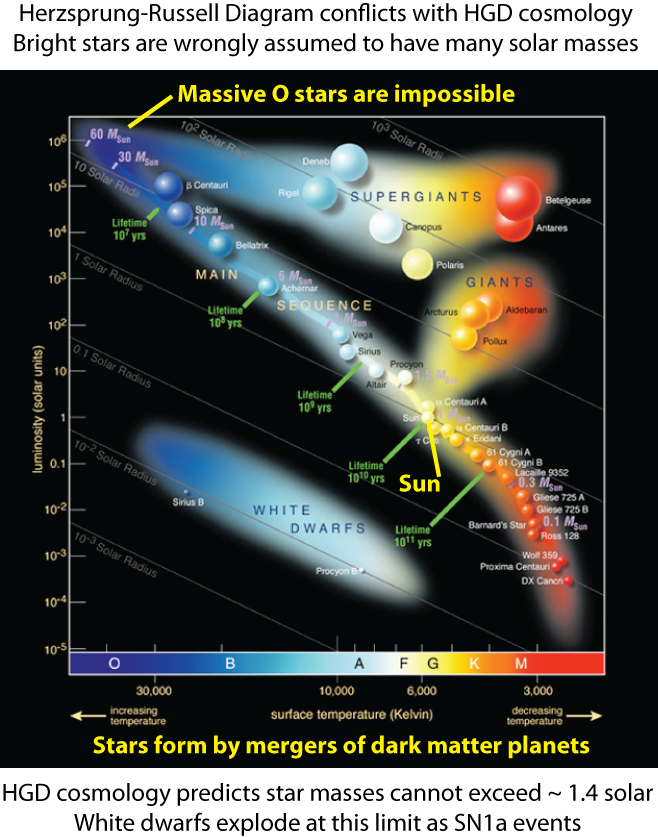
The main sequence of stars was thought to begin with massive O stars at upper left that evolved by highly questionable methods, often inconsistent with modern fluid mechanics.
Figure JC2016.26.3.5 Shows that turbulence based on inertial-vortex forces works universally everywhere. Flight MH370 was a victim of Catastrophic Equatorial Icing at the site shown by the red star in the figure. No mechanism can explain a crash in the South Indian ocean where the search has concentrated based on false conspiracy theories involving "Rogue Pilots". A billion dollar two year search near Australia to find the plane and its occupants has failed, and should not be abandoned but relocated north to the South China sea. There the search has as strong chance of success in a few weeks. given the confirmed Pemba island MH370 debris location and Reunion Island discovery (black star) of a MH370 flaperon only 115 days after the March 8, 2014,
tragedy. The rapid MH370 debris transit is explained by southerly winter monsoon winds in March and the usual strong trade wind drift speeds of MH370 debris emerging from the Sunda Strait between Sumatra and Indonesia. MH370 debris drift from the "Rogue Pilot" location to either Pemba or Reunion Islands is virtually impossible. Therefore the "Rogue Pilot" hypothesis should be rejected and the likely cause of the tragedy should be identified as Catastrophic Equatorial Icing CEI. The search for the plane should be immediately shifted to the South China Sea (red star) location. Because of global warming, the range of risky latitudes for CEI has apparently increased by a factor of two or three since AF447 crashed in the Atlantic at 3 deg N, pp 13957-13958. The CEI range of risky latitudes has been extended by the Myanmar June 8, 2017, crash, to ~10 N latitude. A military plane on routine shcdule crashed in clear weather killing > 100 northwest of the MH 370 location off the Myanmar (Burma) coast, see Figure JC2017.26.10.2 below.
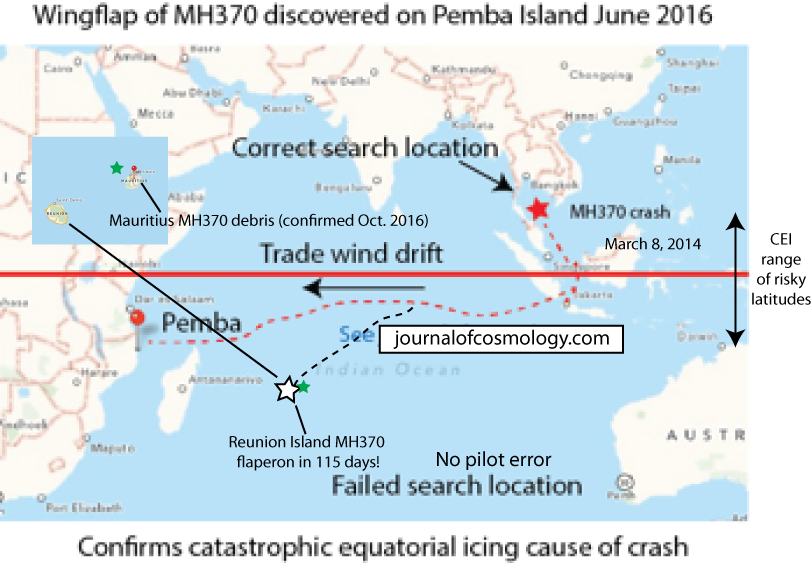
MH370 debris continues to be discovered on beaches from Pemba to Reunion Island, proving that the plane went down at the South China Sea location shown by the red star in the figure. It is quite impossible for this drift to happen in only 115 days starting from the failed "Rogue Pilot" search location near Perth, Australia. Part numbers confirm that a third piece of debris found on Mauritius (green star), near Reunion Island, is from MH370. Please contact the responsible Australian authority
Honorable Darren Chester MP if you agree that the evidence suggests MH 370 is probably an example of Catastrophic Equatorial Icing rather than some "Rogue Pilot" conspiracy, and that the search area should therefore be immediately shifted to the South China Sea (red star) location. Letter sent to Honorable Darren Chester MP October 13, 2016, pp 13959-13961.
Figure JC2016.26.3.5.1 Plane crashes near Medallin, Colombia, Nov. 29, 2016, killing most of a Brazil Soccer team on board. Blame was first assigned to an electrical circuit fault, although some of the 77 passengers and the Captain thought the plane had simultaneously both run out of fuel (very unlikely since all planes have ample emergency reserves) and lost circuitry (also unlikely to ever happen, and certainly not simultaeously). A CEI event crashes a plane in only four minutes, so autopilot warnings from iced-over pitot tubes, and rapid altitude loss from an iced-over plane and control surfaces, could easily suggest false fuel and circuit problems. Survivor reports (4 possible) and the flight recorders are needed to determine the most probable
cause of the tragedy, which the Captain clearly knew was coming from his desperate sounding last voice message (he and all the crew were killed). The black boxes were recovered intact soon after the heavy
rains, typical of CEI events, permitted access. Were the fuel tanks really empty? The latitude of the tragic crash ~ 7 N matches that of the MH370 catastrophic equatorial icing event
(now proved in Figure JC2016.26.3.5 but still blamed on "rogue pilots"), suggesting that CEI played a role in bringing the plane down, and more likely
was the only cause. See New York Times Nov. 30, 2016 article, pp 13962-13963. If the pilot were really running out of gas and was not crazy or "rogue" he would have stopped in
Bogota to fill up, since it is precisely on the flight path to Medallin and has many airports.
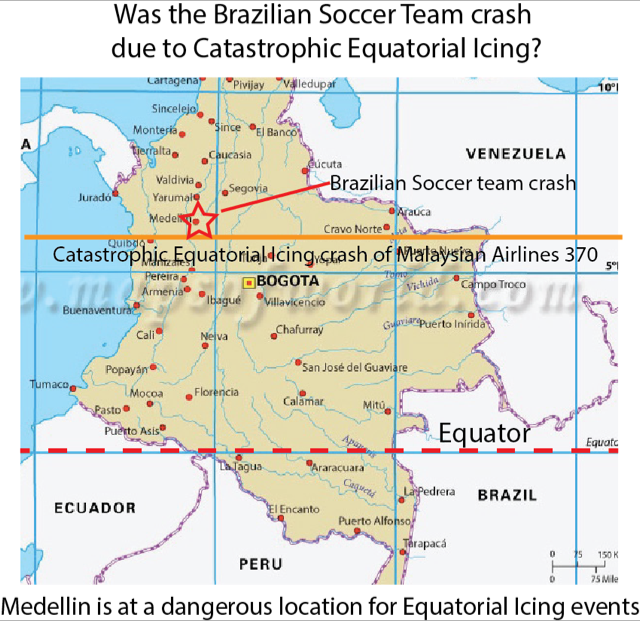
Figure JC2016.26.3.5.2 Shows the Papahanaumocuacia (Northwest Hawaiian Islands) Marine National Monument, recently extended to the 200 mile limit by President Obama. This gives an area greater than twice the size of Texas (>1,500,000 km^2) for which the United States is responsible. This huge region of the ocean (blue rectangle) could be used as a national laboratory for the scientific study of all aspects of oceanography. Possibly some of the costs for the studies can be recovered from solar energy and plastic waste collection. Large amounts of plastic waste have accumulated in the great "garbage patch" from Pacific Rim countries, and must be dealt with and monitored in any case, pp 13964-13965.
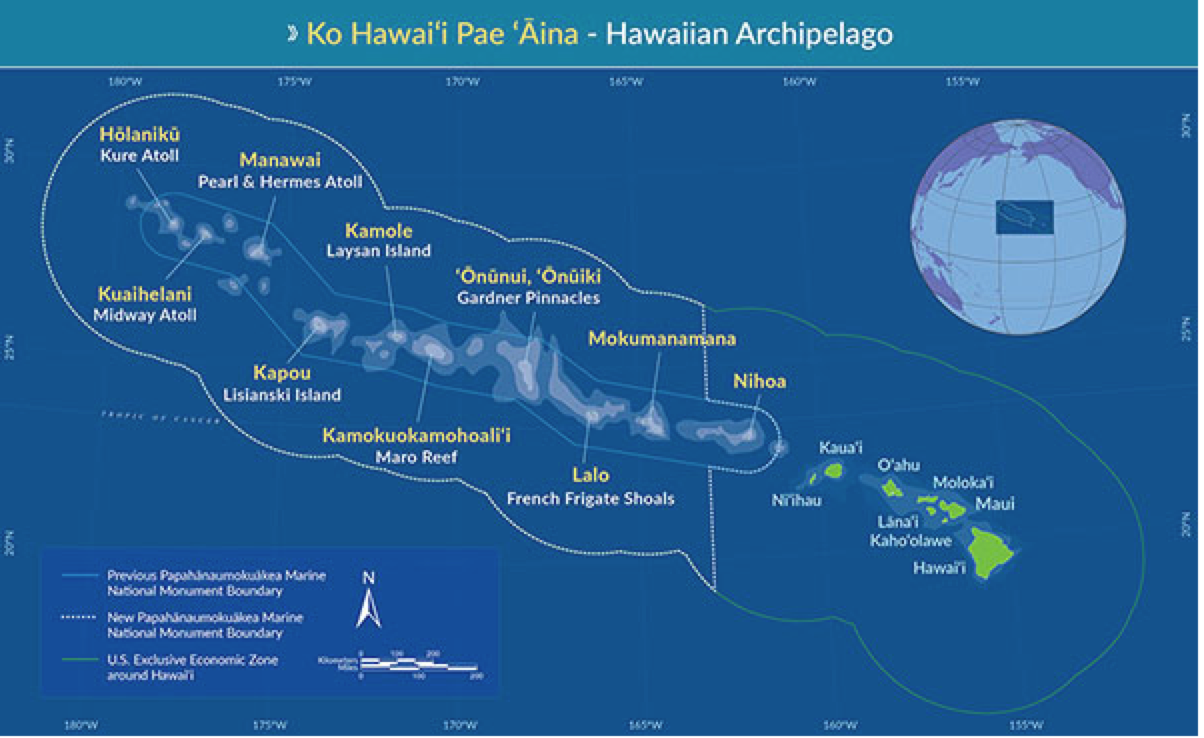
In "THE QUANTITATIVE DISTRIBUTION AND CHARACTERISTICS OF NEUSTON PLASTIC IN THE NORTH PACIFIC OCEAN, 1985-88", Day et al 1989 (student of Prof. Lynne Talley of SIO) report planckton net 1/2 mm particles easily mistaken for marine food. Intermittent massive clumps of floating plastic ropes are seen (eyewitness personal communication, Prof. John Hildebrand at SIO). The Papahanaumocuapia Marine National Monument should immediately begin the task of collecting and recycling this biologically hazardous trash as part of a scientific monitoring program. The recycled value of the plastic is in the range billions of dollars per year. The wasted solar energy in such a large area is worth trillions of dollars a year! What are the costs of ignorance of turbulence and its consequences such as Catastrophic Equatorial Icing and fossil turbulence mixing? The string of Hawaiian islands represents fossil turbulent mixing from BZTMA beamed zombie turbulence maser action mixing chimnies created when Earth and another dark matter planet last merged and remelted, reducing the viscosity of the molten central rocky layers until they became sufficiently turbulent for many BZTMA mixing chimneys to propagate from a turbulent liquid outer core of an ancient earth and melt through the solid mantle and plastic (aesthenosphere), forming a string of volcanoes and islands in the lithosphere as it slides to the north-west over the fossil turbulence "hot spot". The kinematic viscosity of the present aesthenosphere is ~ 10^24 m^2 s^-1 from glacial rebound rates (personal communication Professor Robert Parker at SIO). This is ~ 1% of the photon-electron kinimatic viscosity of the plasma when protogalaxies fragmented at 10^12 seconds, pp 13966-13967.
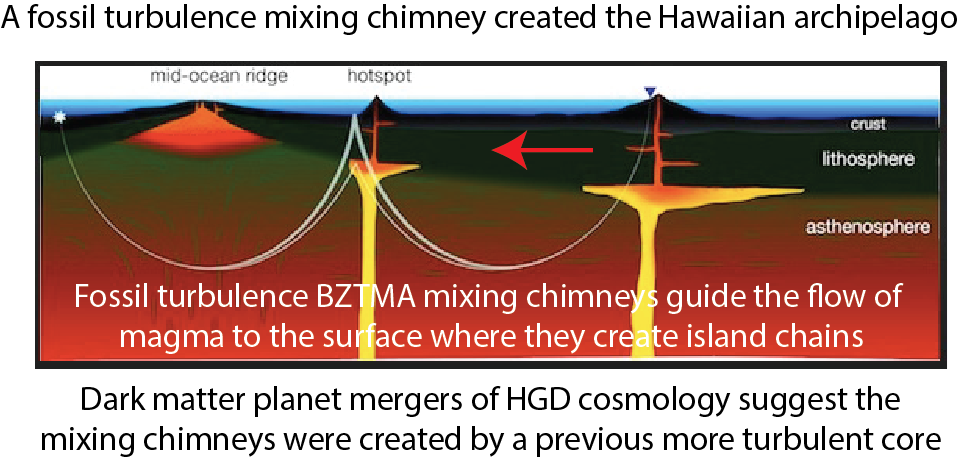
Figure JC2016.26.3.5.3 The crust and lithosphere move in the direction of the red arrow, carrying islands of the archipelago with them created by the hot spot on the right. Once a channel has been created, subsequent magma flows will likely only follow the radial fossil turbulence channels of BZTMA turbulence mixing chimneys produced by planet melting during the most recent dark matter planet merger when the liquid planet core was turbulent. The process is similar to that of lightning bolts in the atmosphere, which repeatedly trace the path of the first flash through the air, following the paths of plasma created by the initial bolts. Sound waves from exposive charges shown by circular archs in the figure are used by oceanographers to study such structures deep in the Earth from slight changes in sound speeds received by hydrophones. From the length of the Hawaiian Archipelago it seems that the time of the last dark matter planet merger was at least a billion years ago, pp14000-14001.
Vol 26, #10. Cosmological evidence that the turbulence problem is solved, Carl H. Gibson, University of California at San Diego, La Jolla CA, 92093-0411. Turbulent Mixing and Beyond Sixth International conference Tenth Anniversary Program, Non-Equilibrium Transport Across the Scales, 14-18 August 2017, The Abdus Salam International Centre for Theoretical Physics, Trieste, Italy. pp 14780-14788.
Poster submitted for Turbulent Mixing and Beyond Tenth Anniversary Program. pp 14789-14799.
Figure JC2017.26.10.1 Evidence from the cosmic microwave background radiation collected by WMAP that the standard CDMHC model is wrong to neglect collisional fluid mechanics and turbulence. Sreenivasan and Bershadski reveal strong evidence of two classes of turbulence. The first is big bang turbulent combustion of Planck particles with large Reynolds number (R_Lambda ~ 1000) and a triple bump signature, and the second is due to turbulence formed by proto-galaxy fluid at the boundary layers of expanding supervoids during the plasma epoch. The second turbulence has a smaller Reynolds number (R_Lambda ~ 40) and the same triple bump signature. The "sonic peak" at ell=200 (~10^24 m) has nothing to do with Baryonic Sonic Oscillations, but is the signature of proto-galaxy fluid turbulence along fossil big bang turbulence vortex lines. The big bang supervoids are much larger (>3x10^25 m) and more difficult to sample.
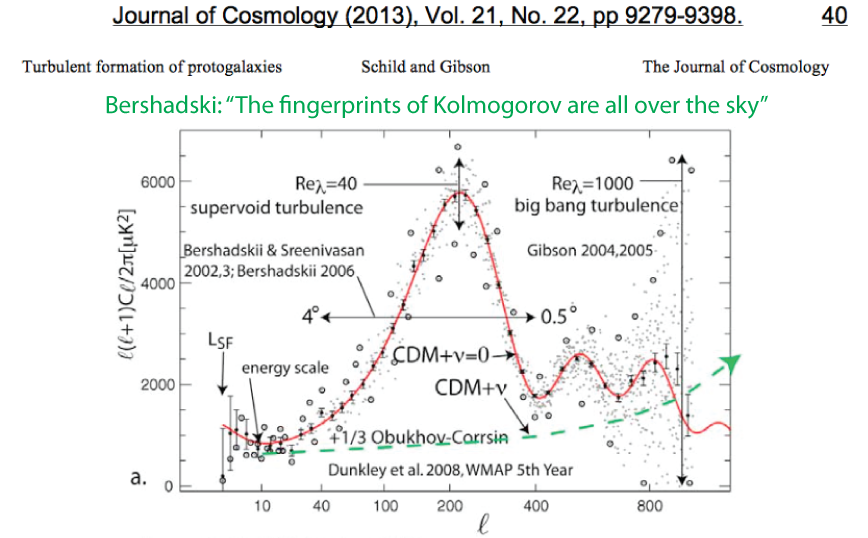
Crucial Re_lambda interpretations of the CMB spectra from WMAP by Sreenivasan and Bershadski (2002,2003), Bershadski (2006) and Gibson (2004, 2005, 2013) that clinch the role of turbulence and Kolmogorovian turbulent mixing in cosmology.
Figure JC2017.26.10.2 Catastrophic Equatorial Icing provides further evidence that the turbulence problem has been solved. A Myanmar military aircraft has mysteriously crashed on a routine flight on June 8, 2017, killing more than a hundred passengers. The location is nearby the Catastrophic Equatorial Icing event that downed the larger MH370 plane March 8, 2014, as shown by the two red stars. Debris and bodies promptly appeared on the Myanmar coast for the military plane, shown in the insert. Some debris from MH370 has been recovered on Runion island and near Mozambique as expected from oceanographic currents, but most of the bodies are likely still in the planes on the sea bottom near the red star locations. Beamed zombie turbulence maser action mixing chimneys of supercooled steam arise near the equator where the Coriolis force vanishes and the turbulence intermittency is maximum, create an intermittent fatal icing danger to aircraft that pass through such chimneys. The risks of such rare CEI events appear to be increasing due to global warming. Monsoon winds explain the southwesterly debris drift in both cases.
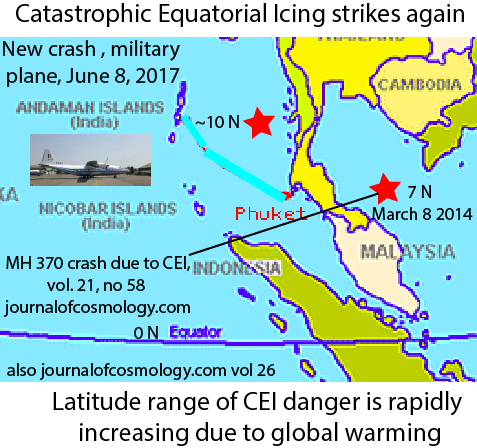
Vol 26, #24. Commentary by Hanlin Liu, Student of Economics and Business Administration at the University of North Carolina at Chapel Hill, on the Coronovirus COVID-19 impact on the attention given to Catastrophic Equatorial Icing, as per Carl
Gibson, Professor at University of California at San Diego.
How Coronavirus and Catastrophic Equatorial Icing Unveil the Mystery of Economic Loss,
pp 15260 - 15261.
Vol 26, #25. Commentary by Carl Gibson, Professor at University of California at San Diego and Hanlin Liu, Student of Economics and Business Administration at the University of North Carolina at Chapel
Hill, on the commentary by Hanlin Liu in #24 above.
How Coronavirus and Catastrophic Equatorial Icing Unveil the Mystery of Economic Loss: Can the Causes be Extraterrestrial?,
pp 15285 - 15286.

Vol 28, #26. Additional Commentary by Carl Gibson, Professor at University of California at San Diego and Hanlin Liu, Student of Economics and Business Administration at the University of North Carolina at Chapel
Hill, on the commentary by Hanlin Liu in #25 above.
How Coronavirus and Catastrophic Equatorial Icing Unveil the Mystery of Economic Loss: Can the Causes be Extraterrestrial?,
pp 15301 - 15305.
Vol 28, #28.
Google CEI - Click HERE
Vol 21, #22. New Cosmology II, C. H. Gibson. Freshman seminar textbook UCSD SIO 87, Winter 2013.
RASP articles are included. Provides further insights into turbulence on the cosmic scale. pp 9279-9398